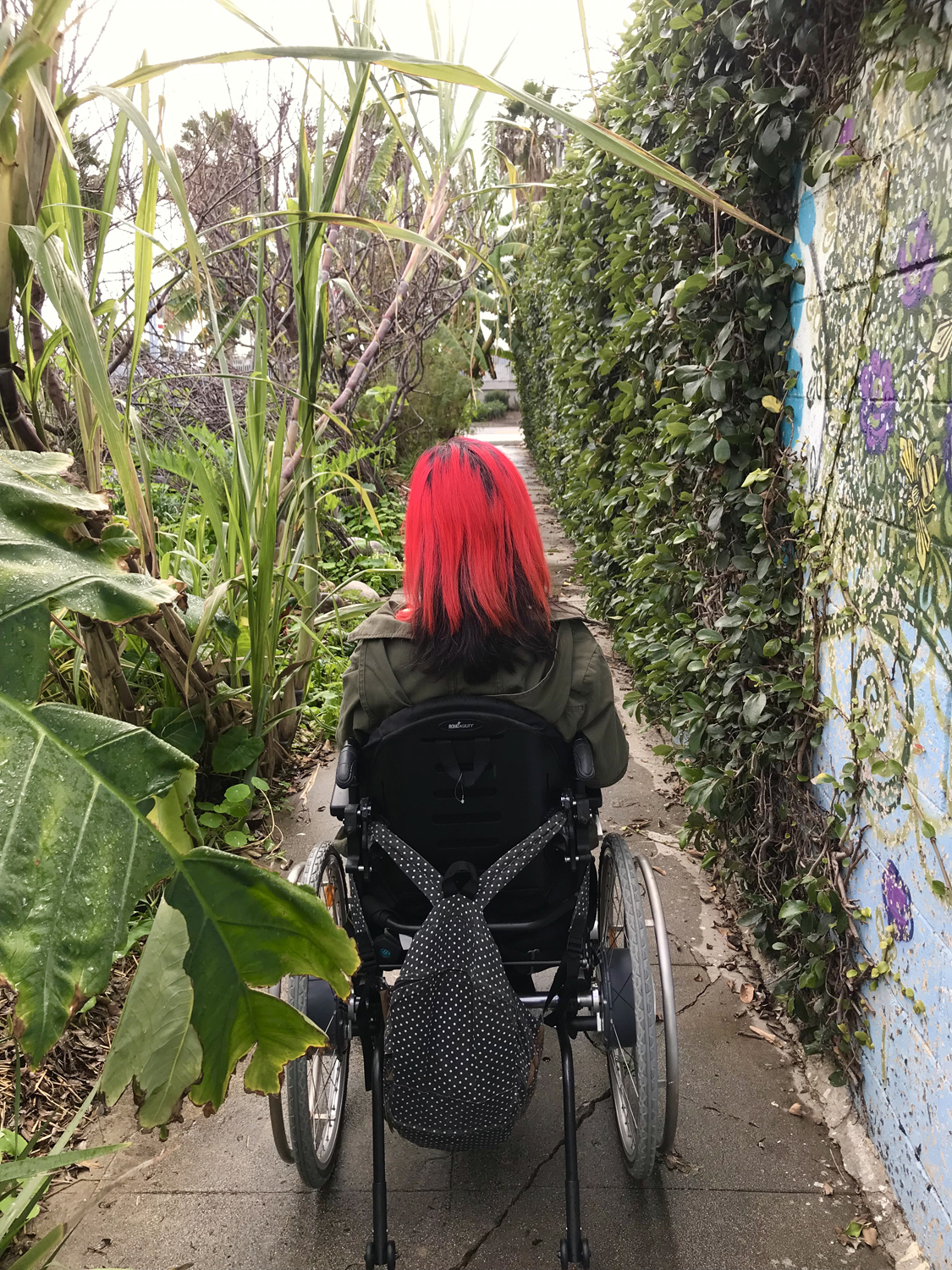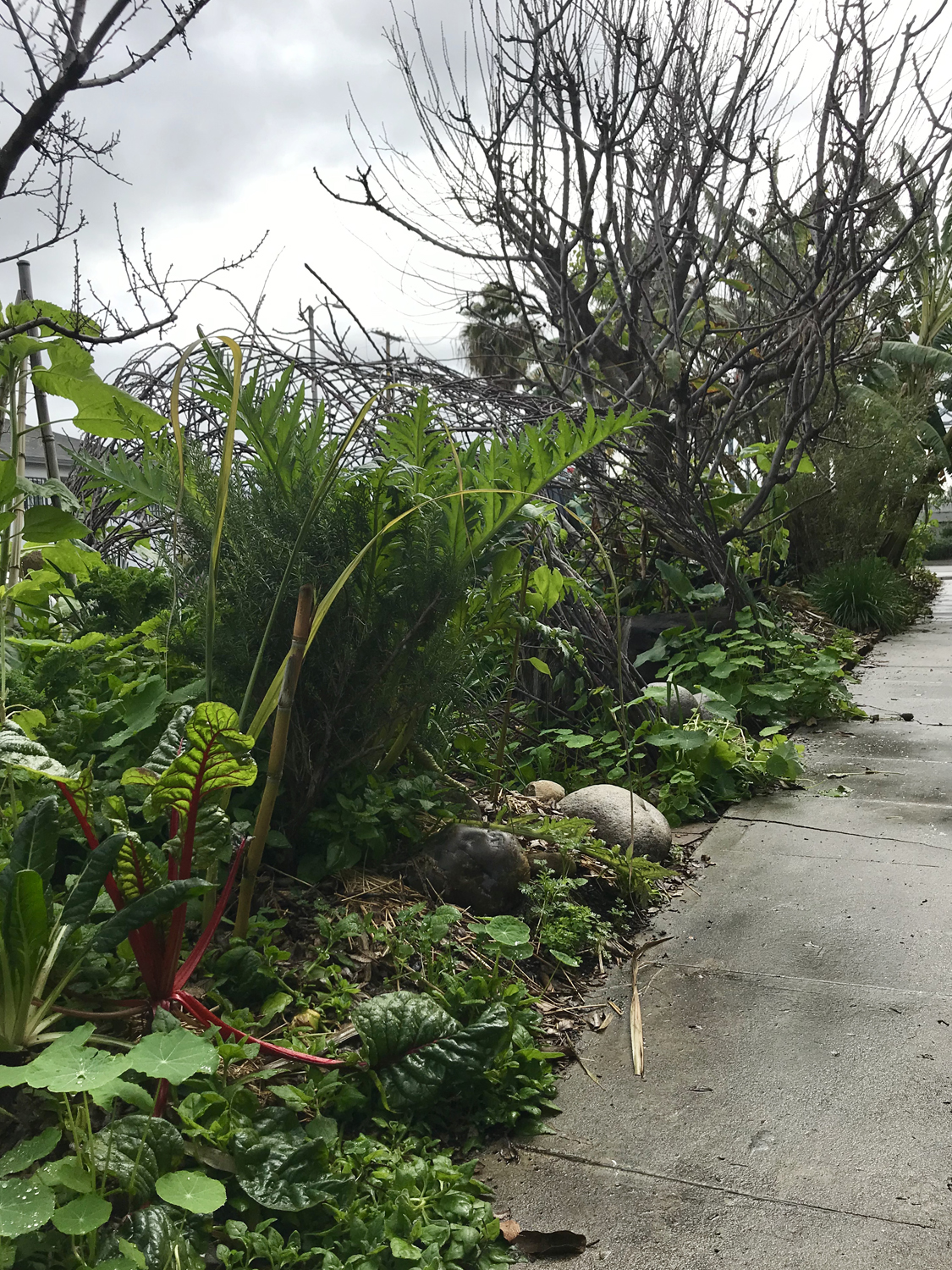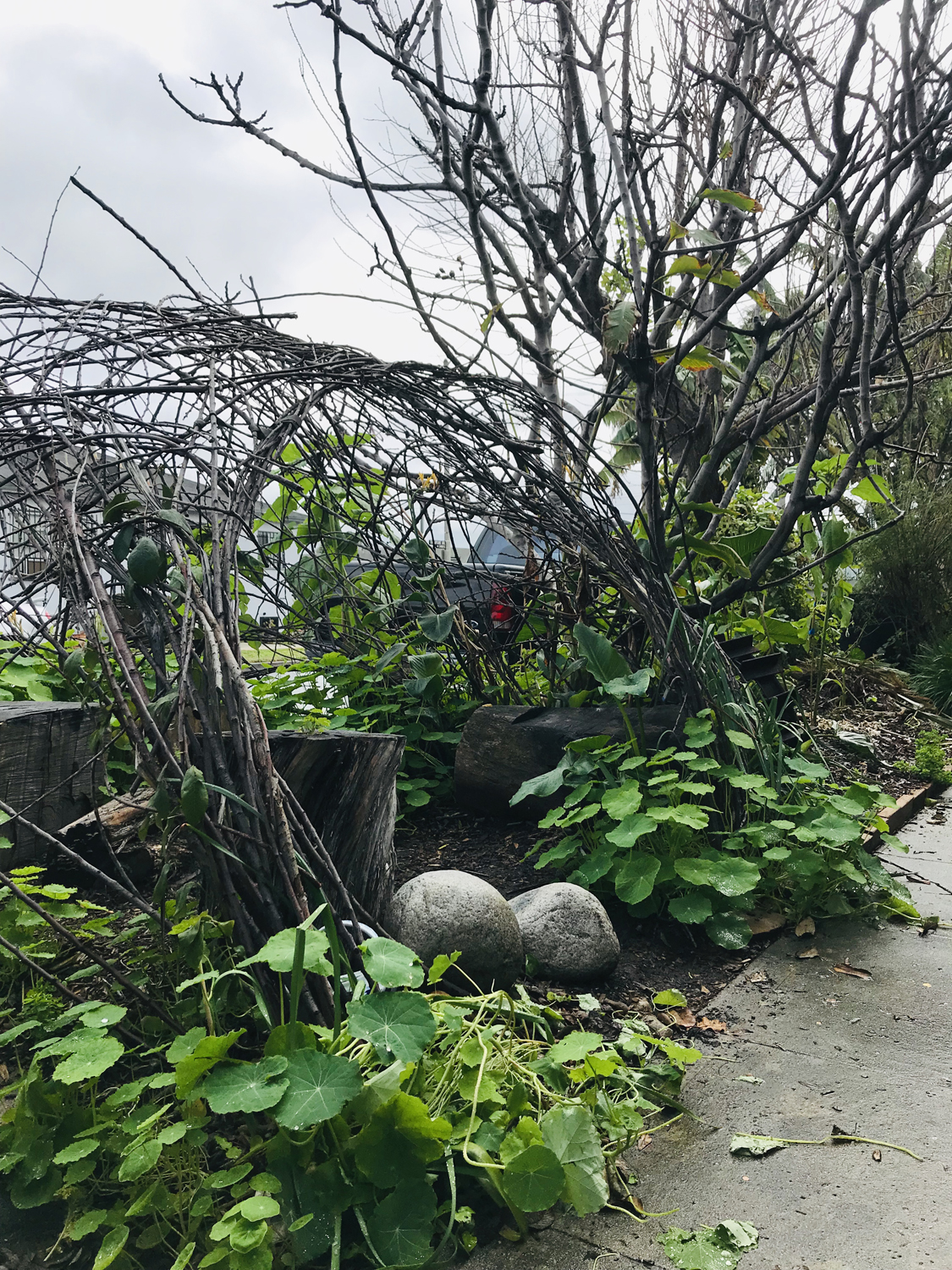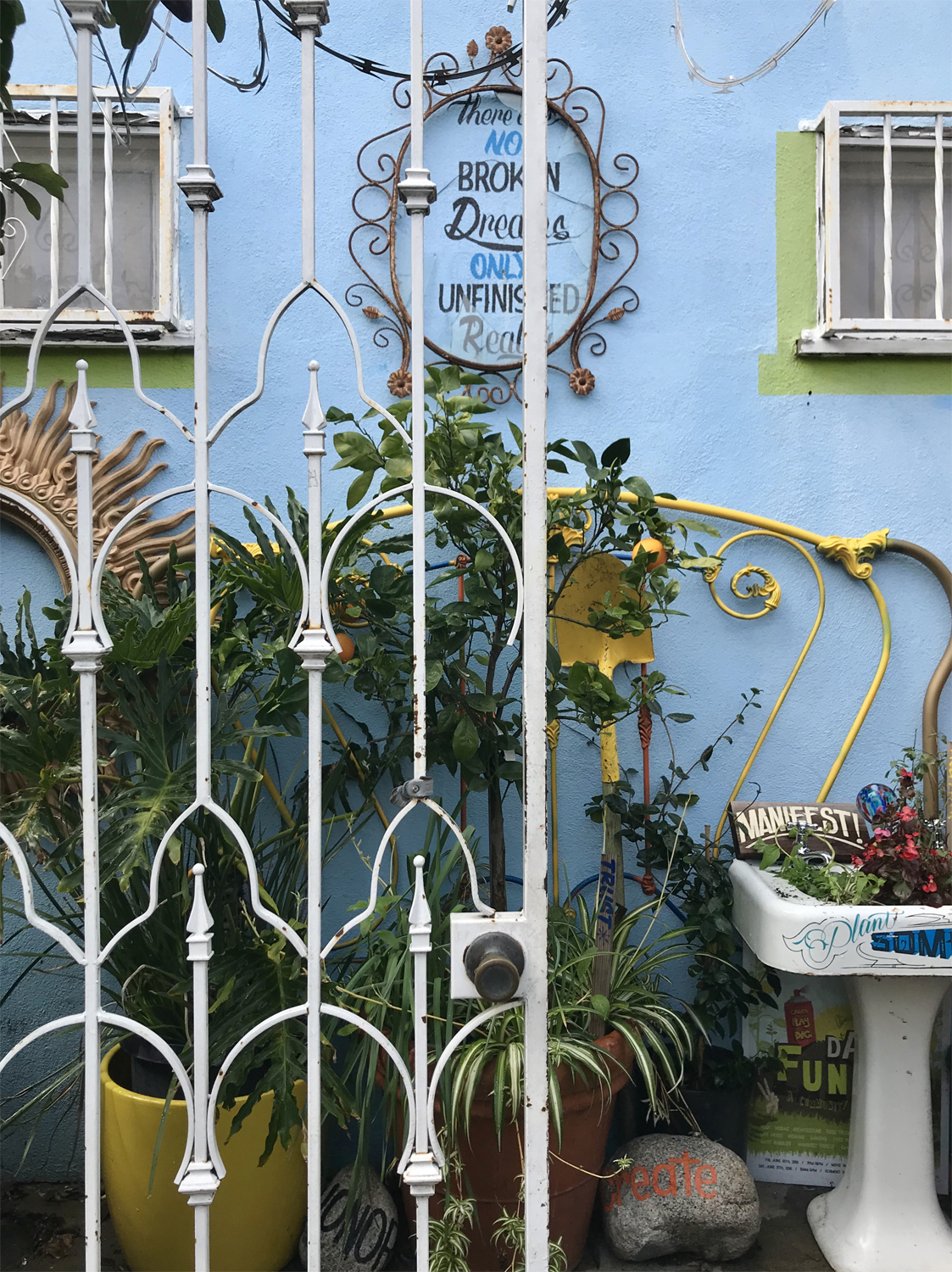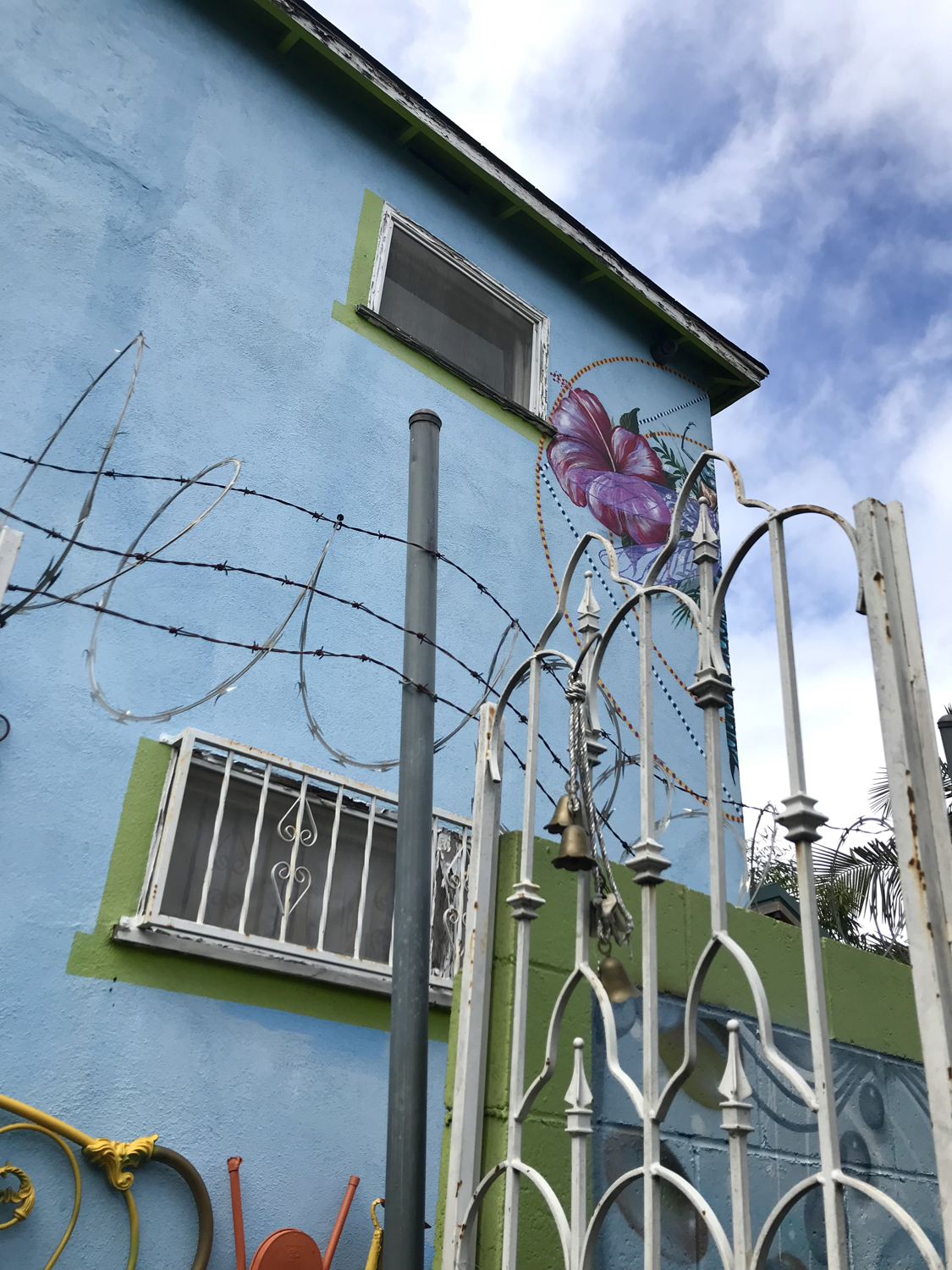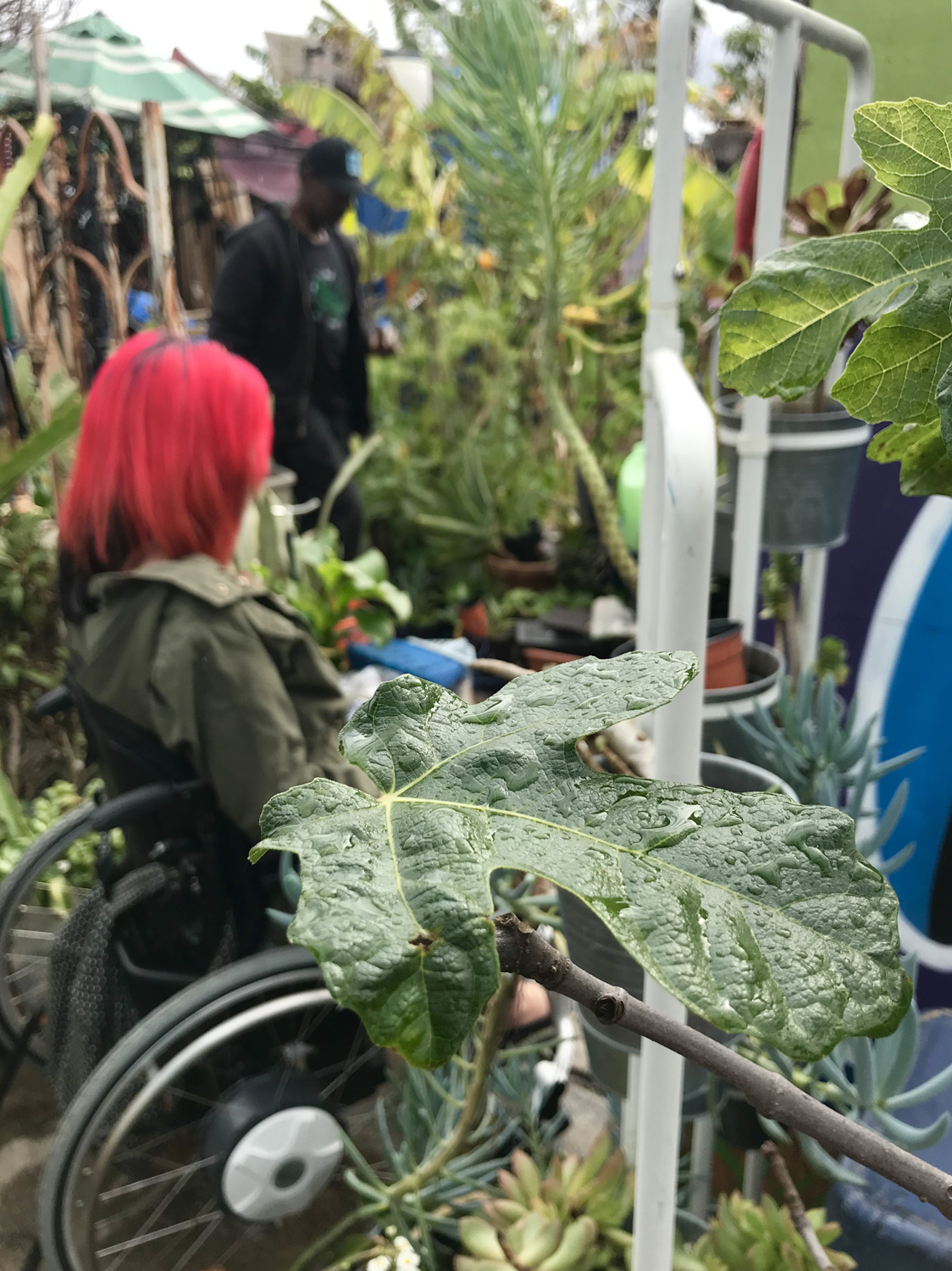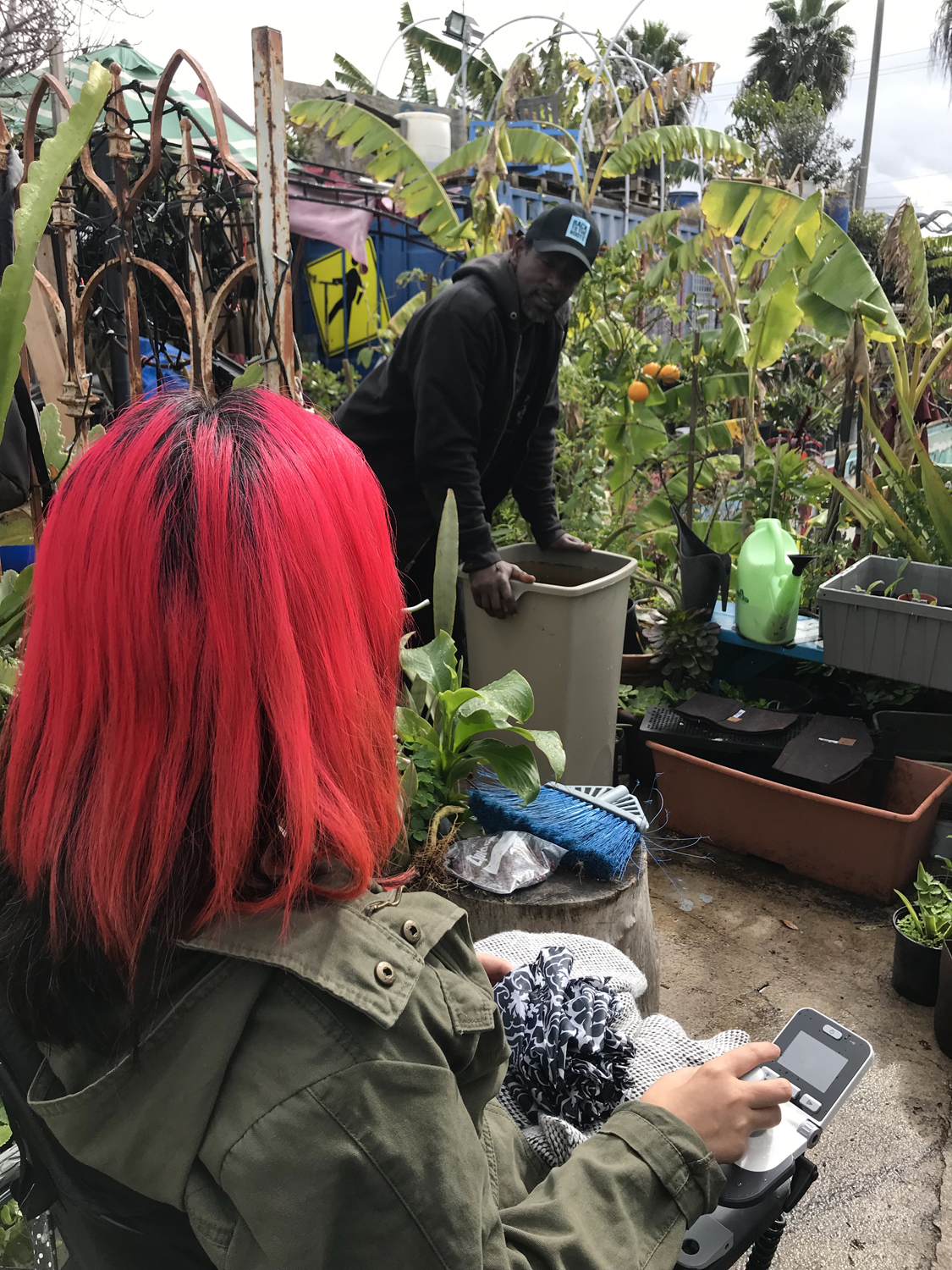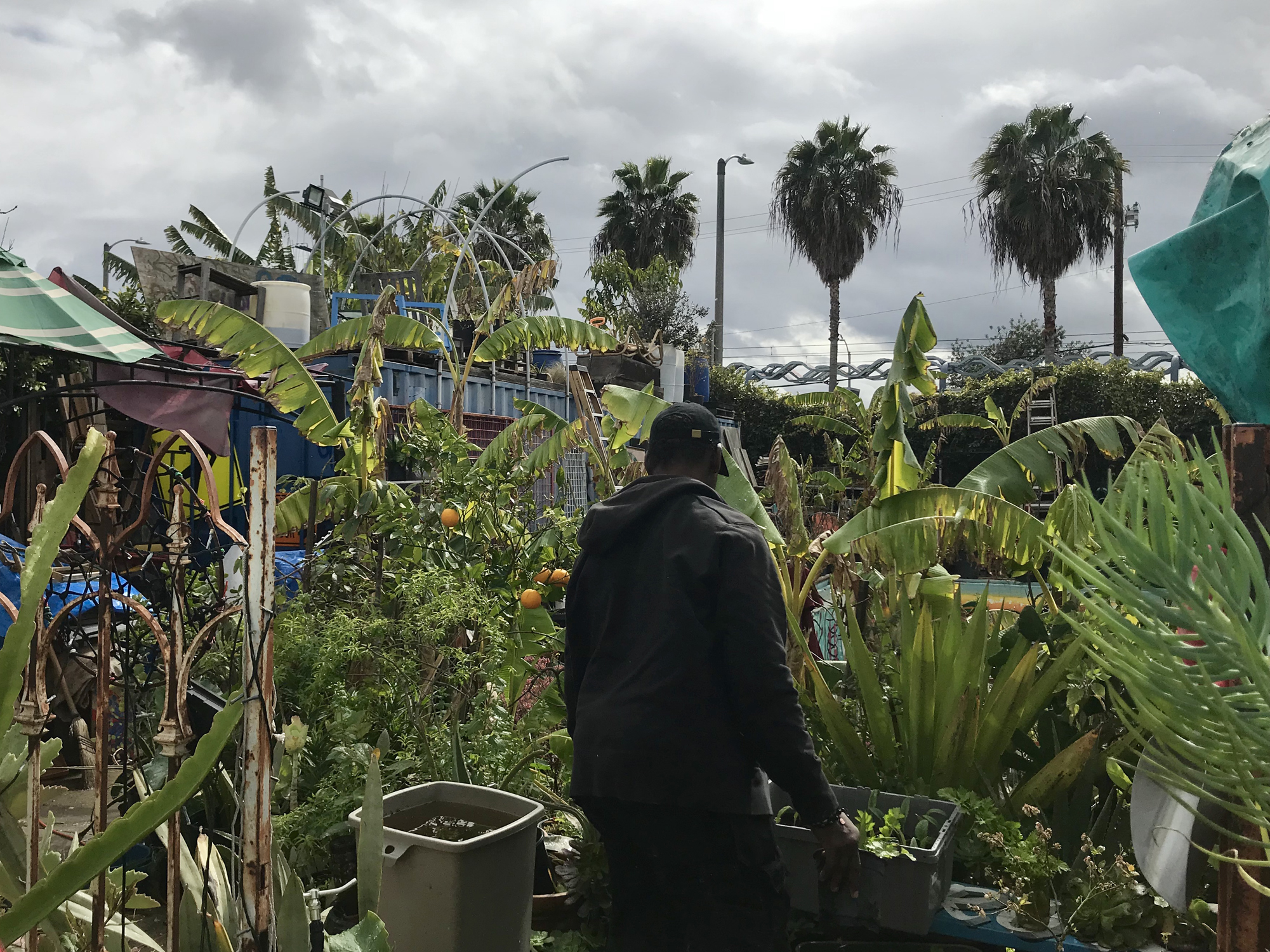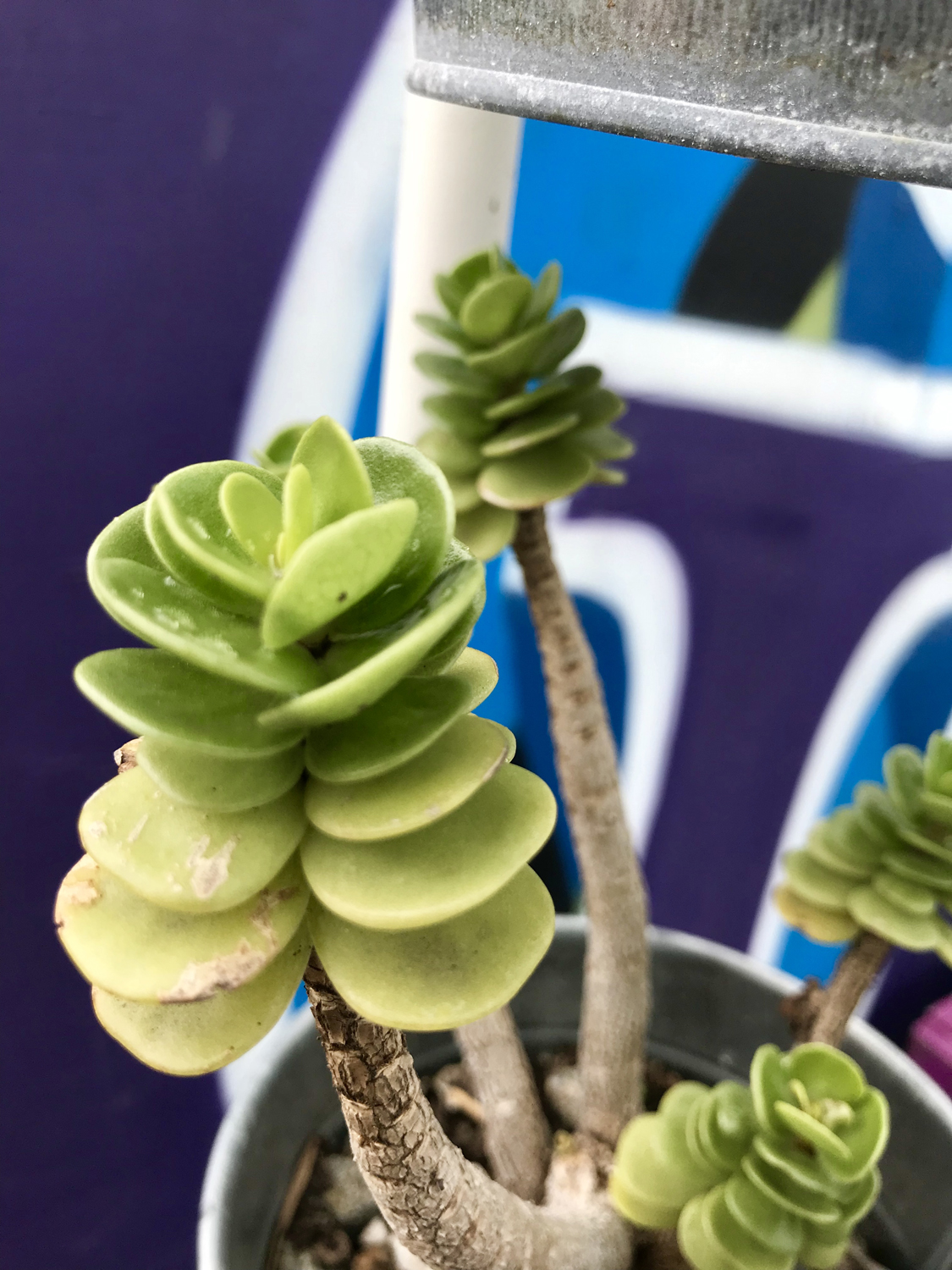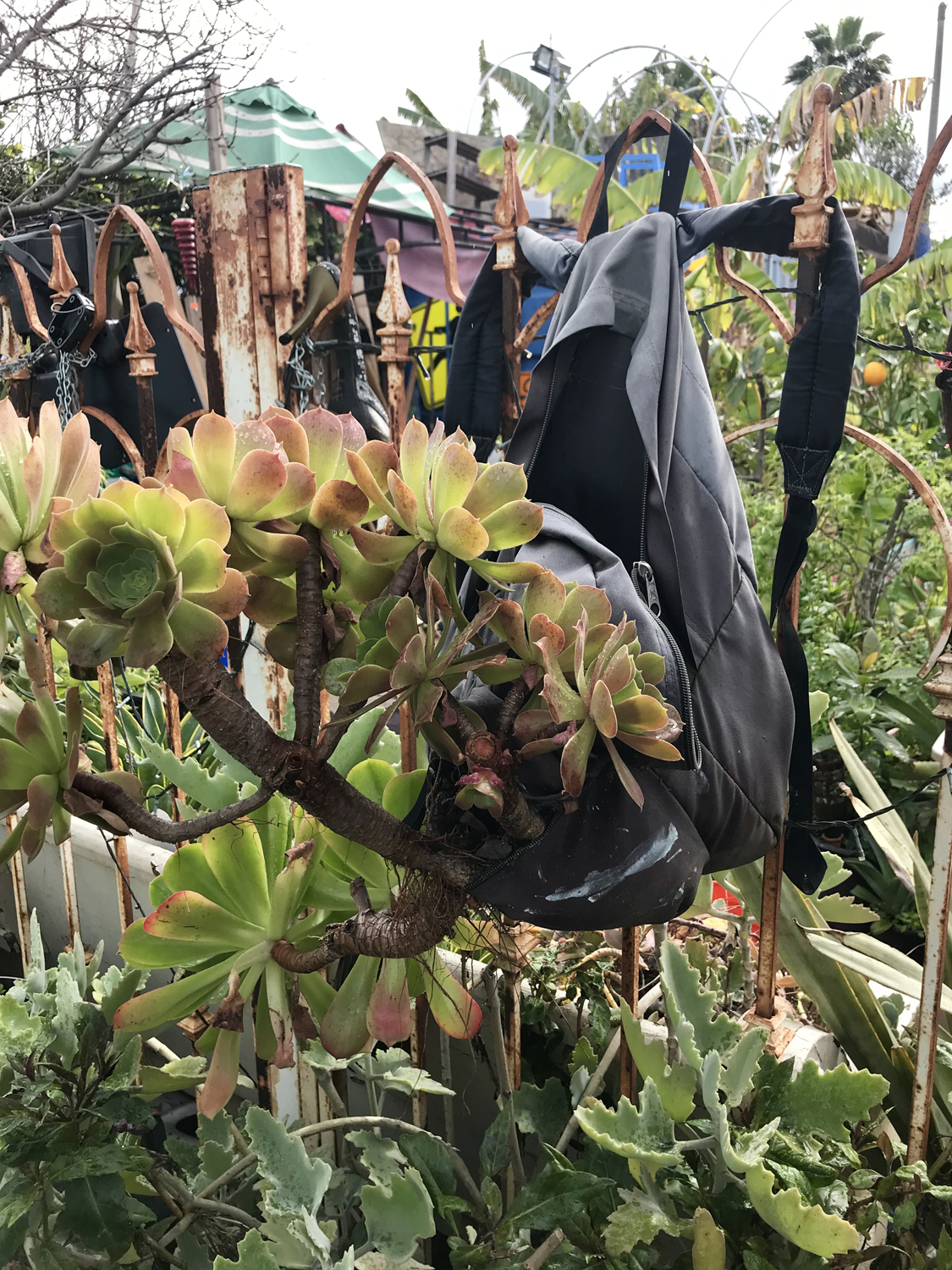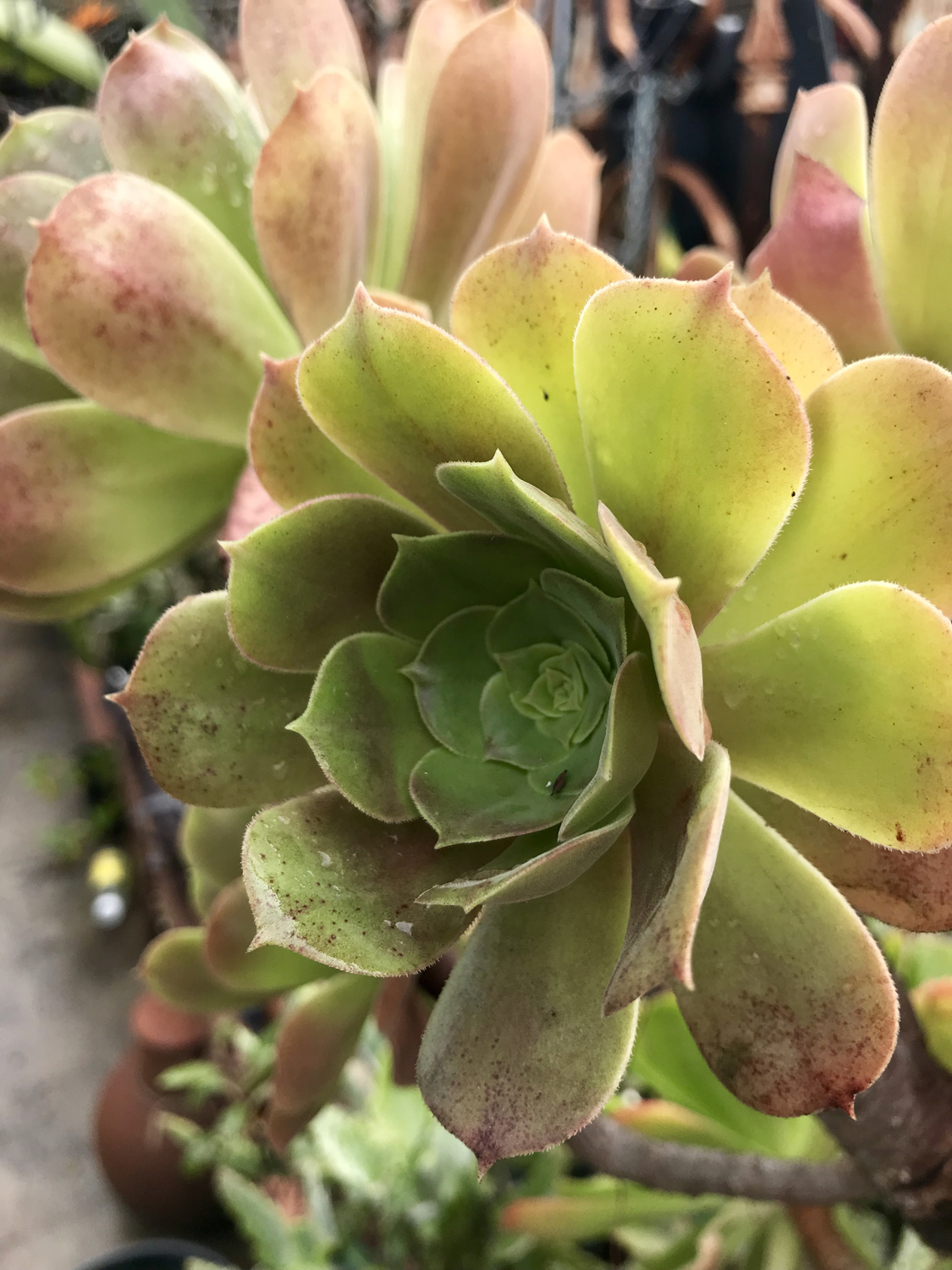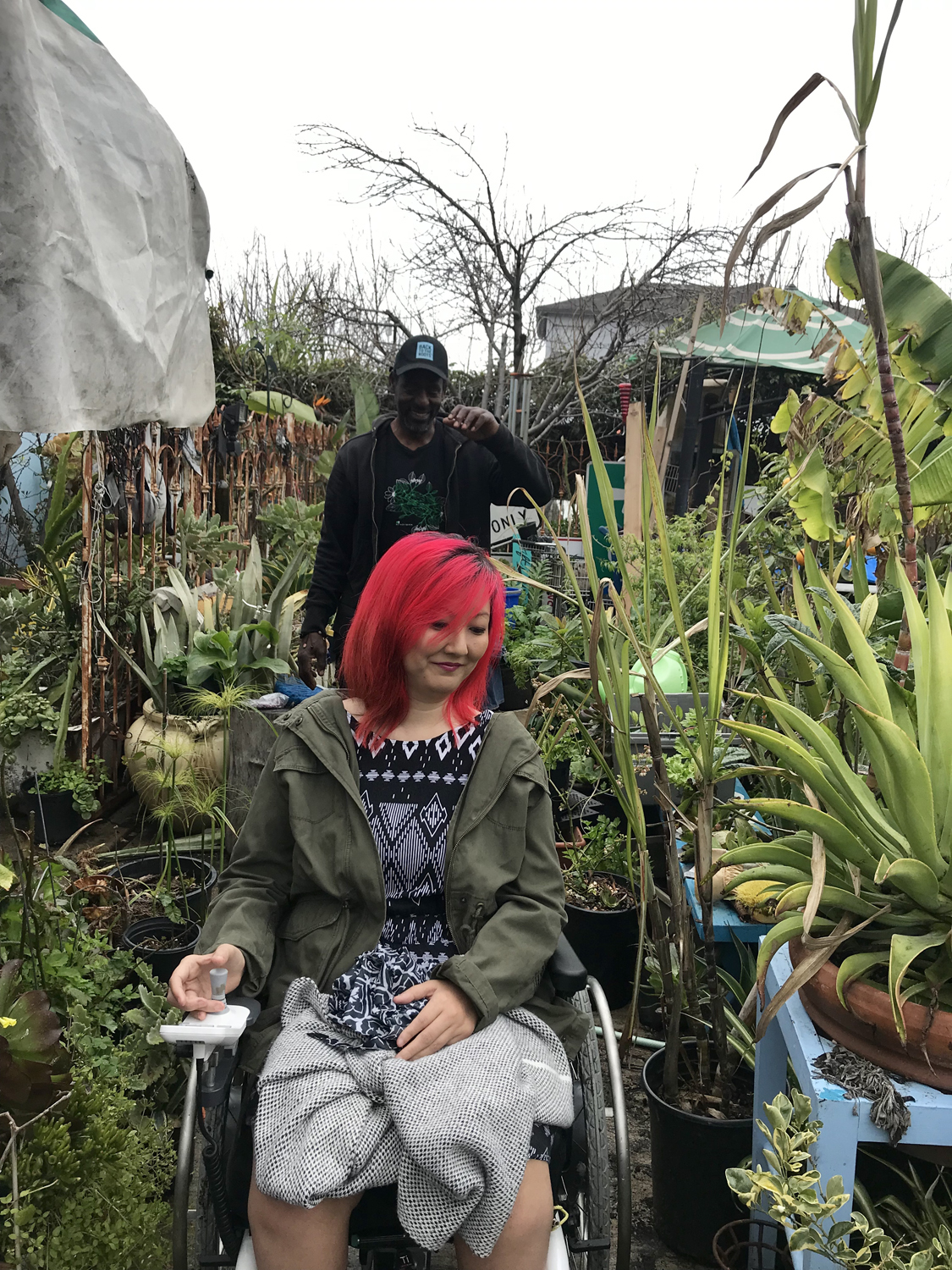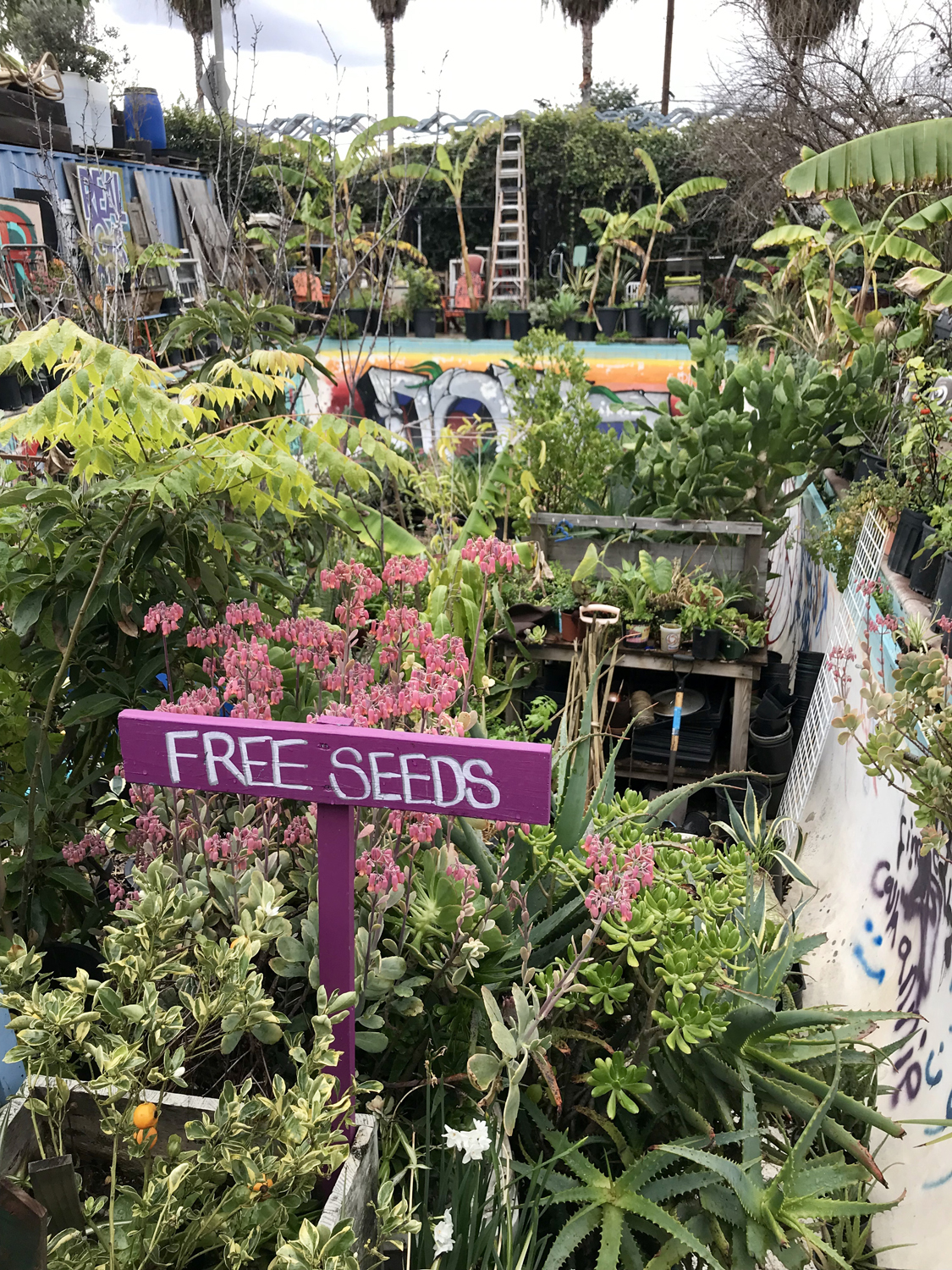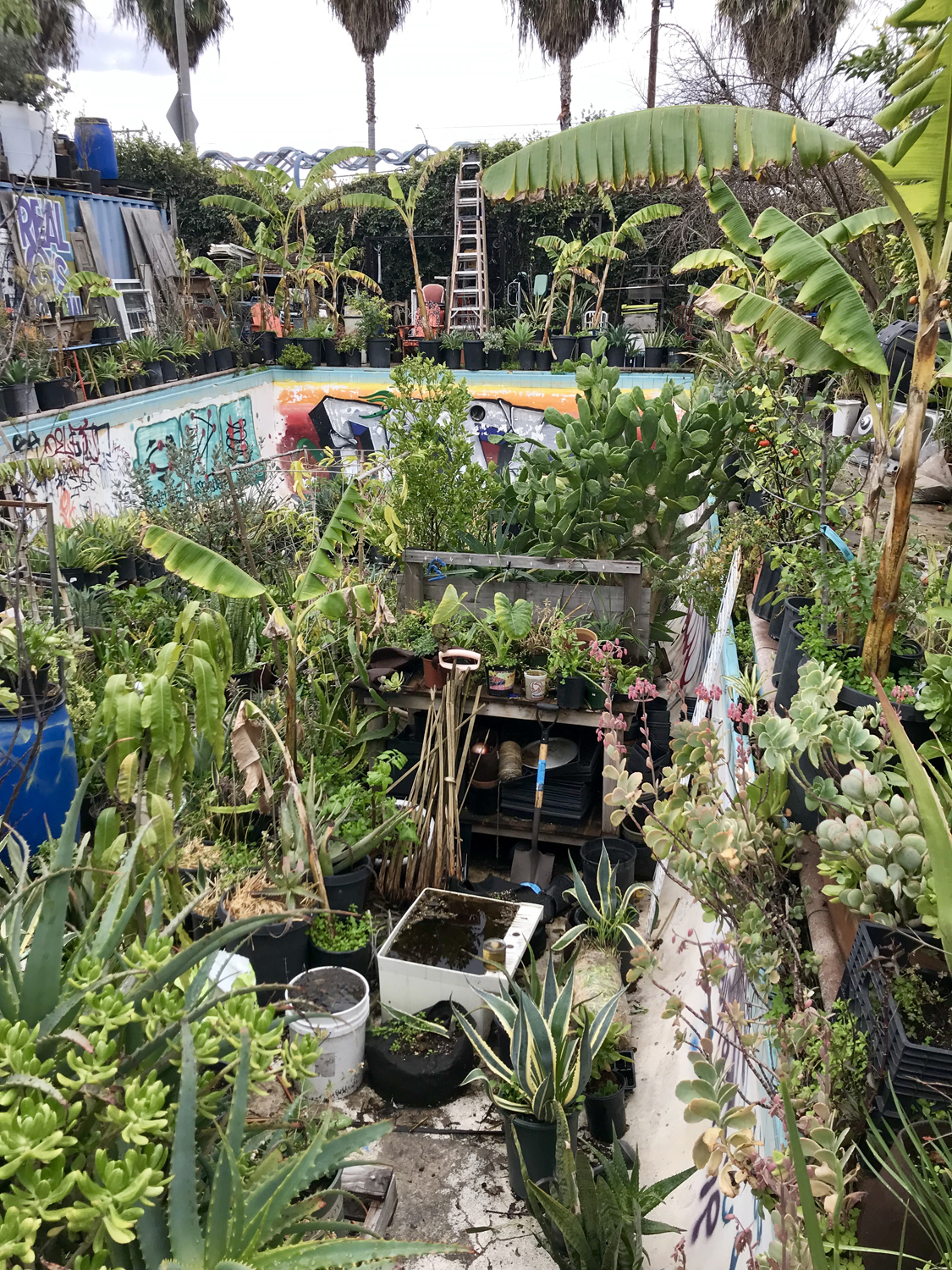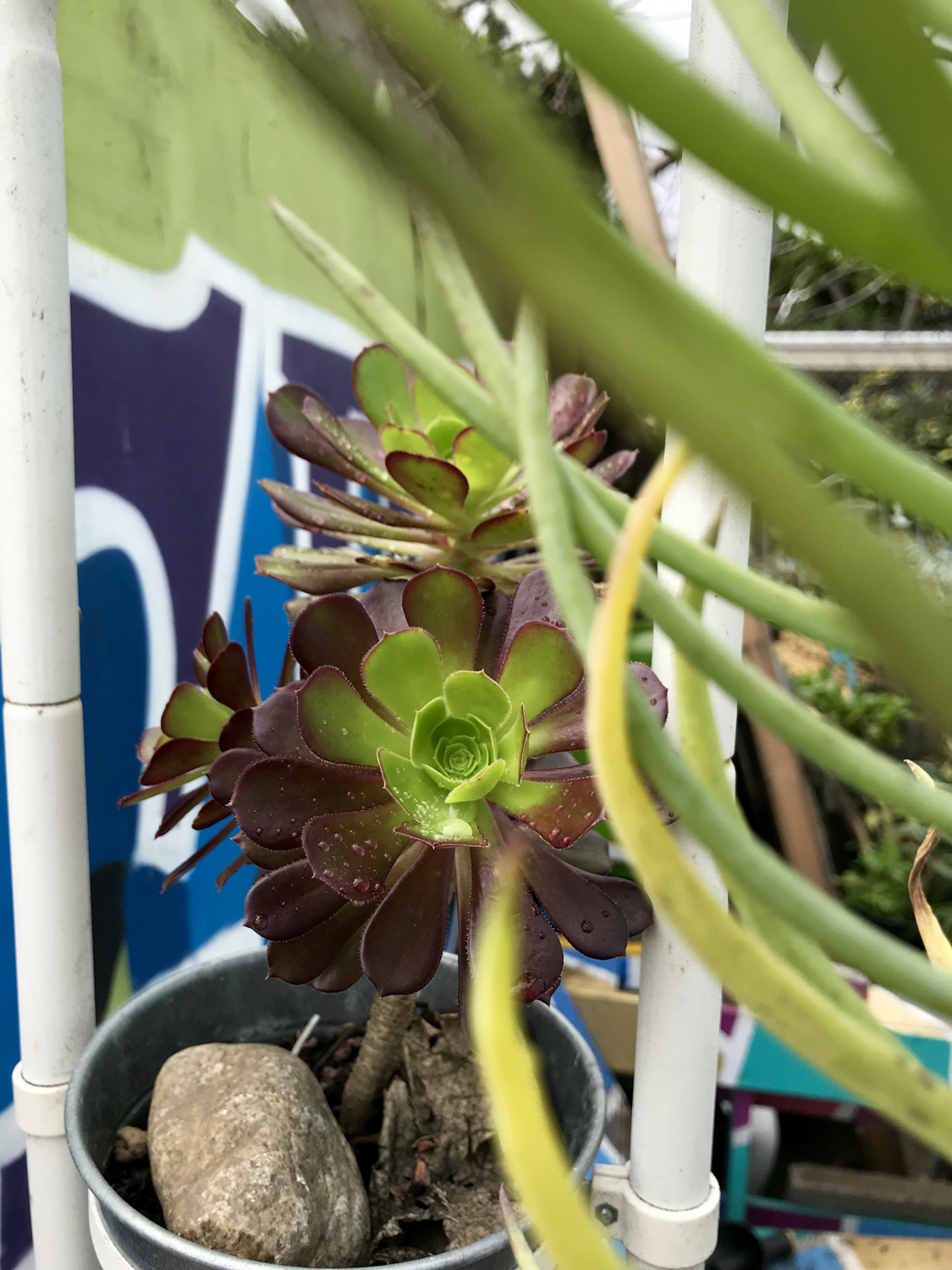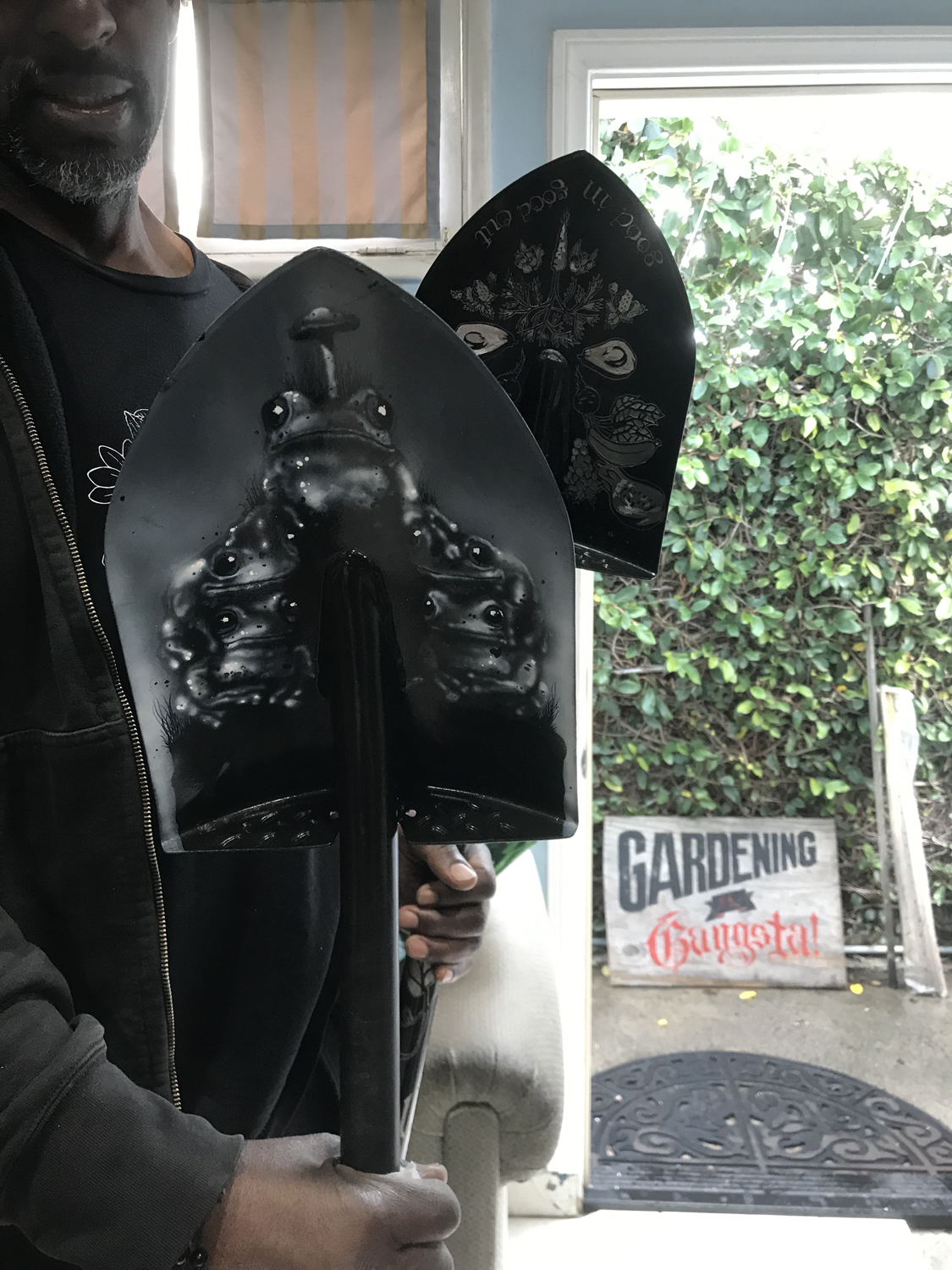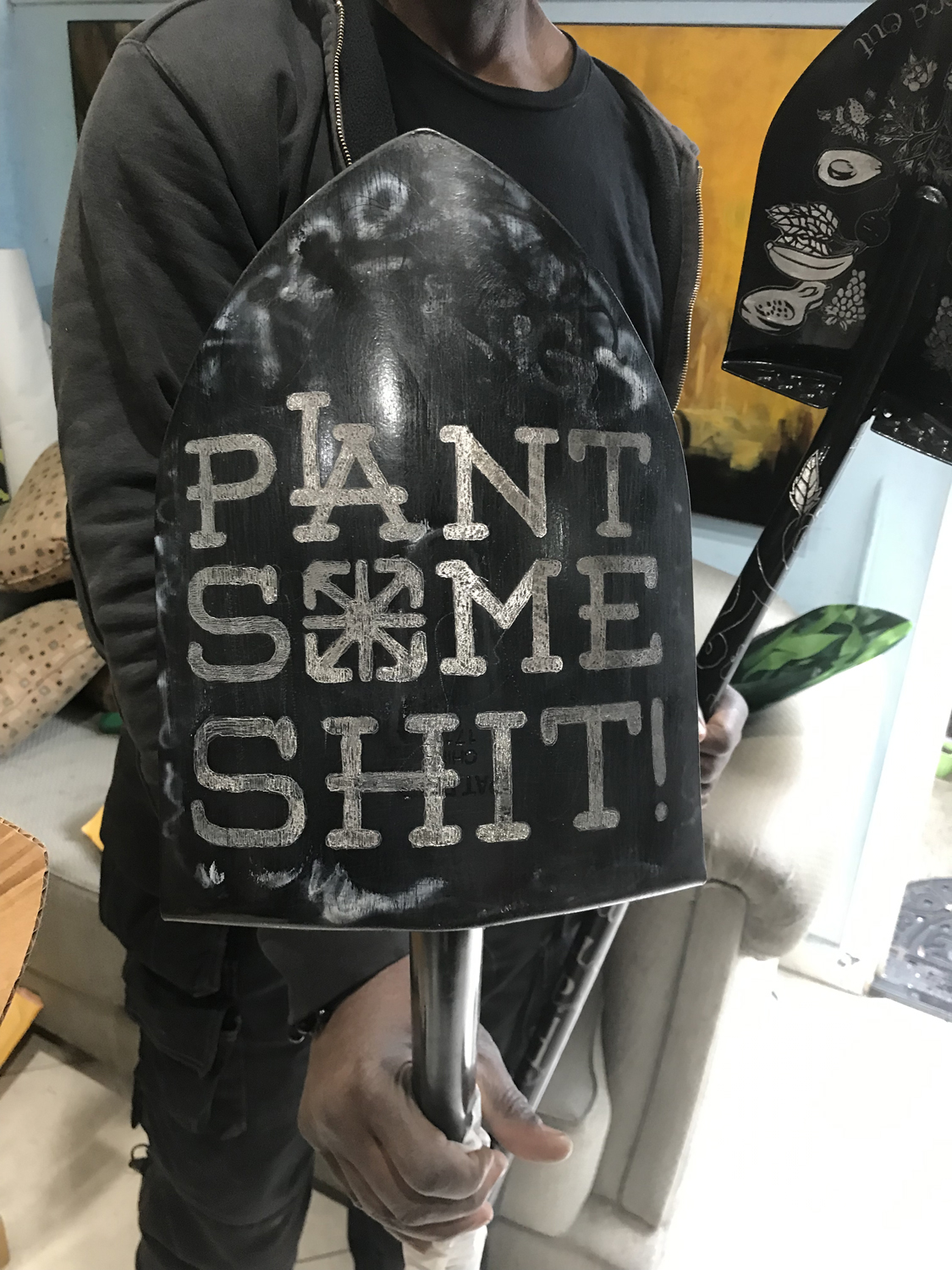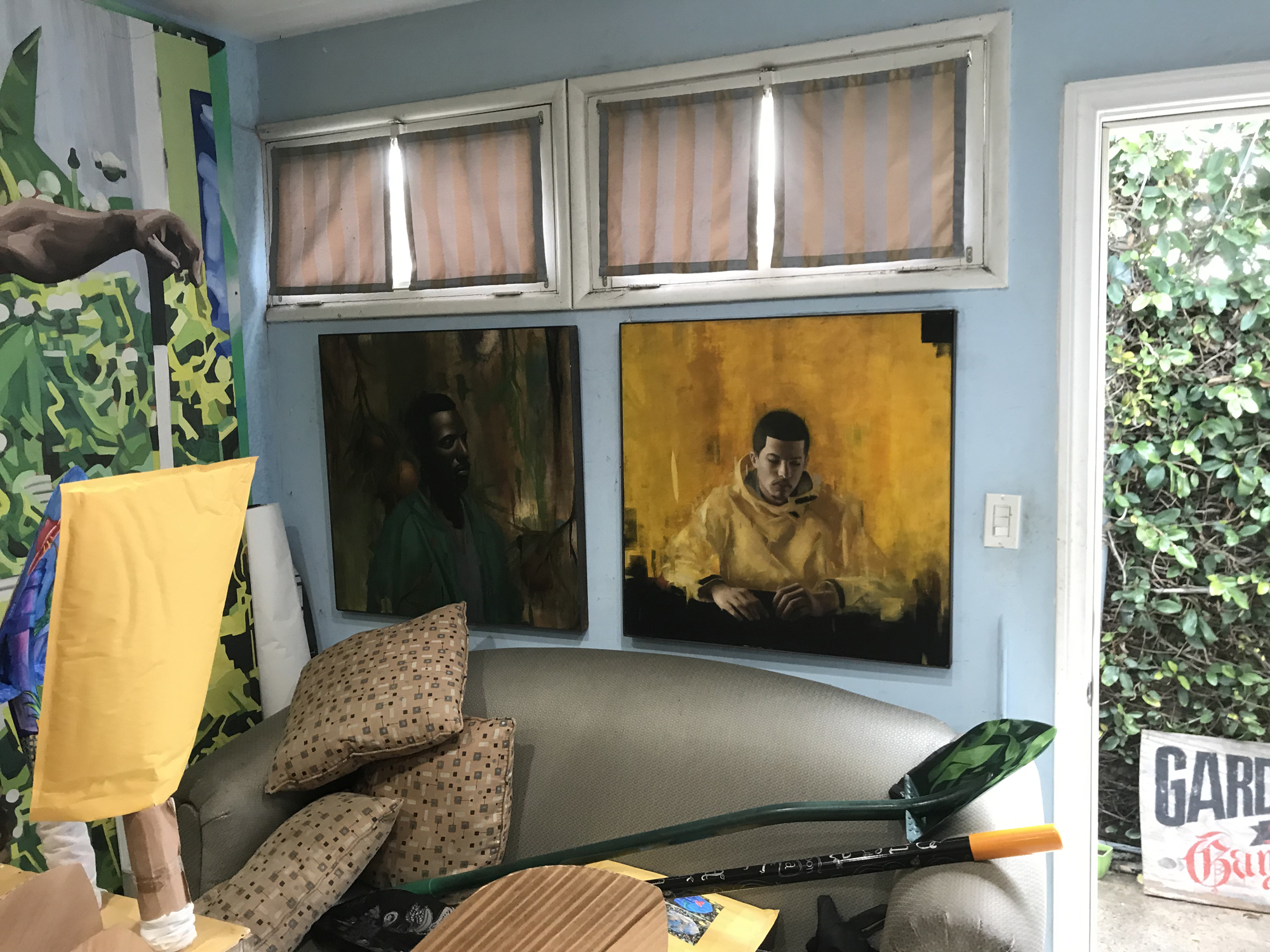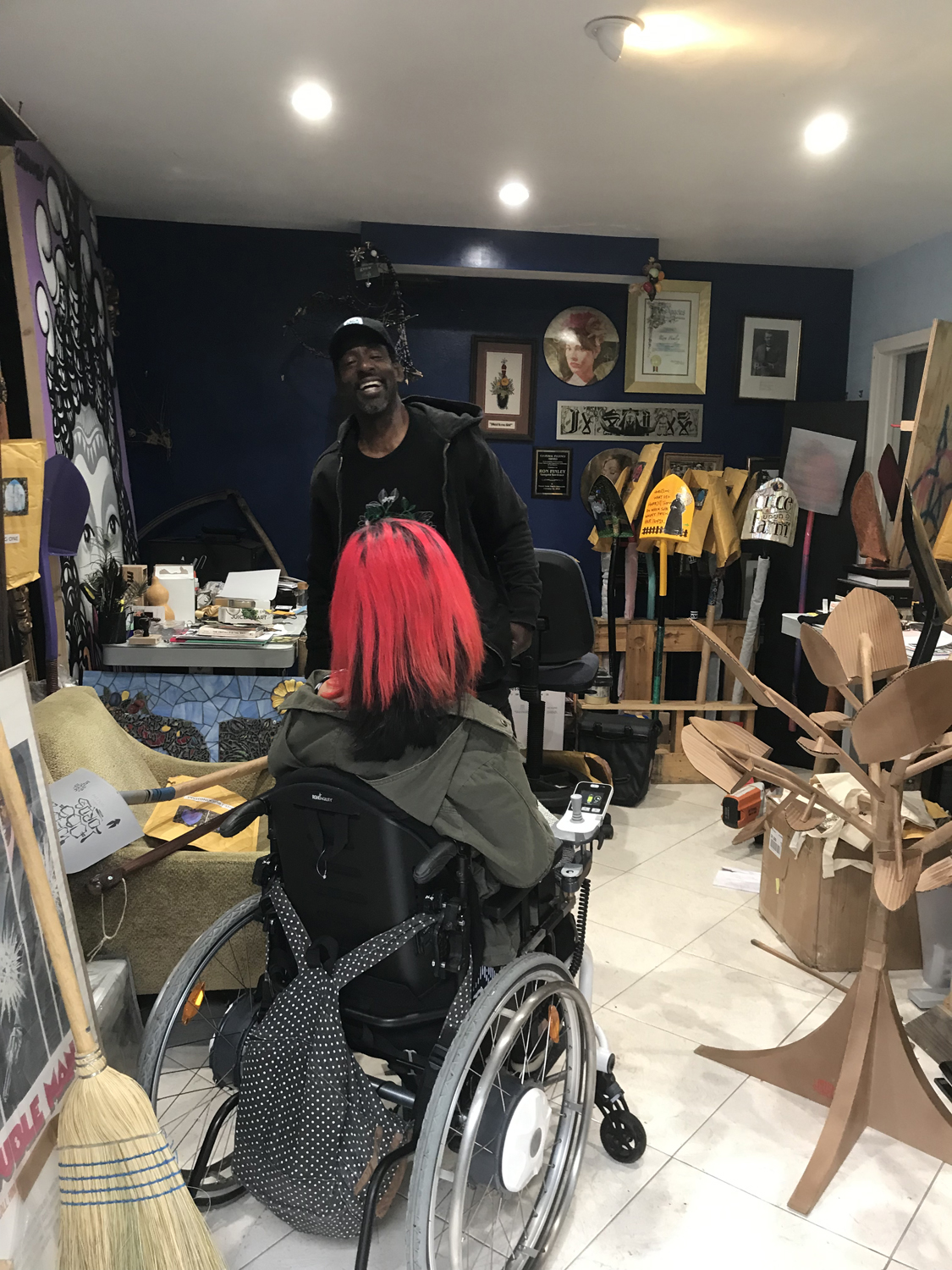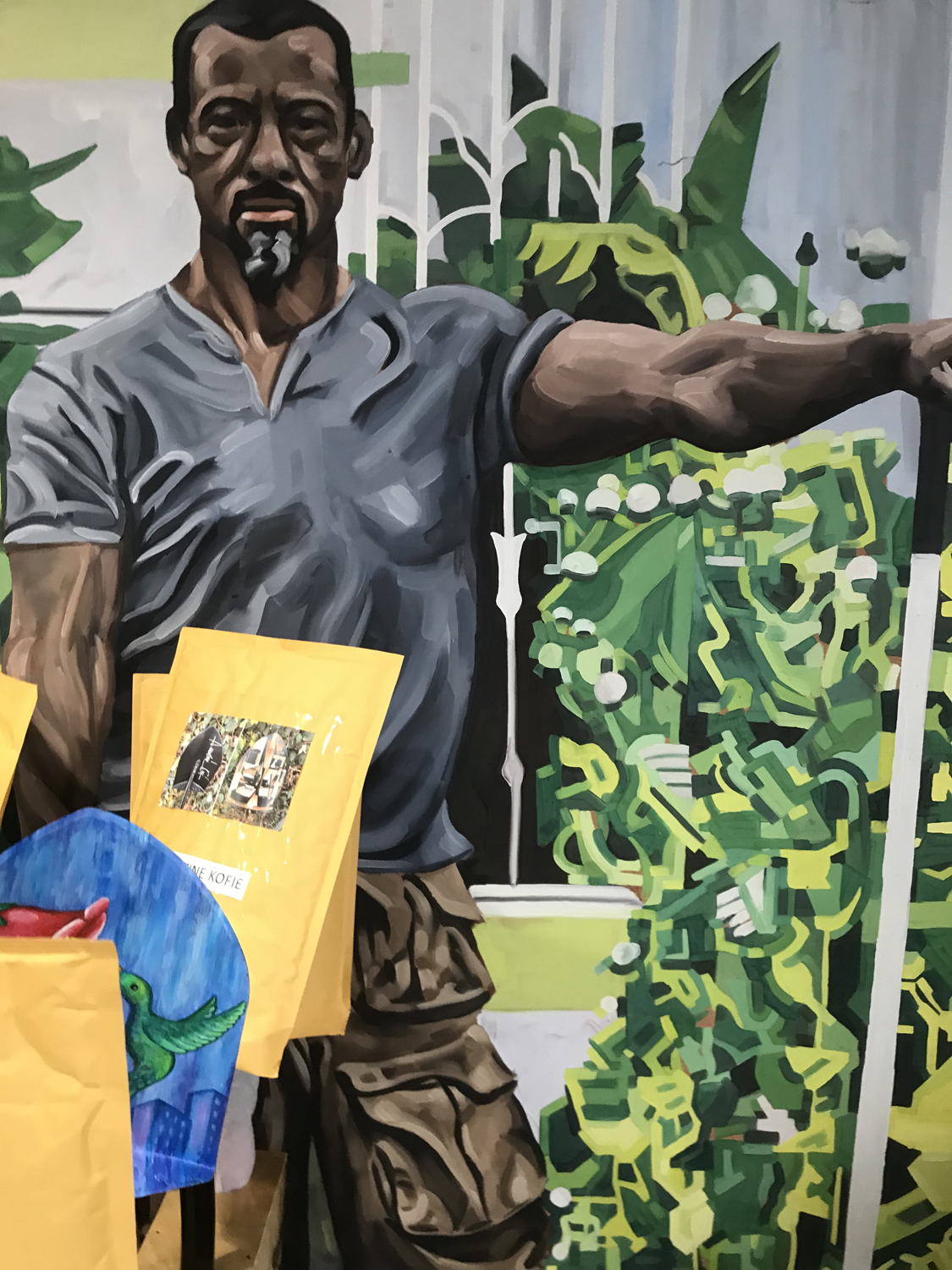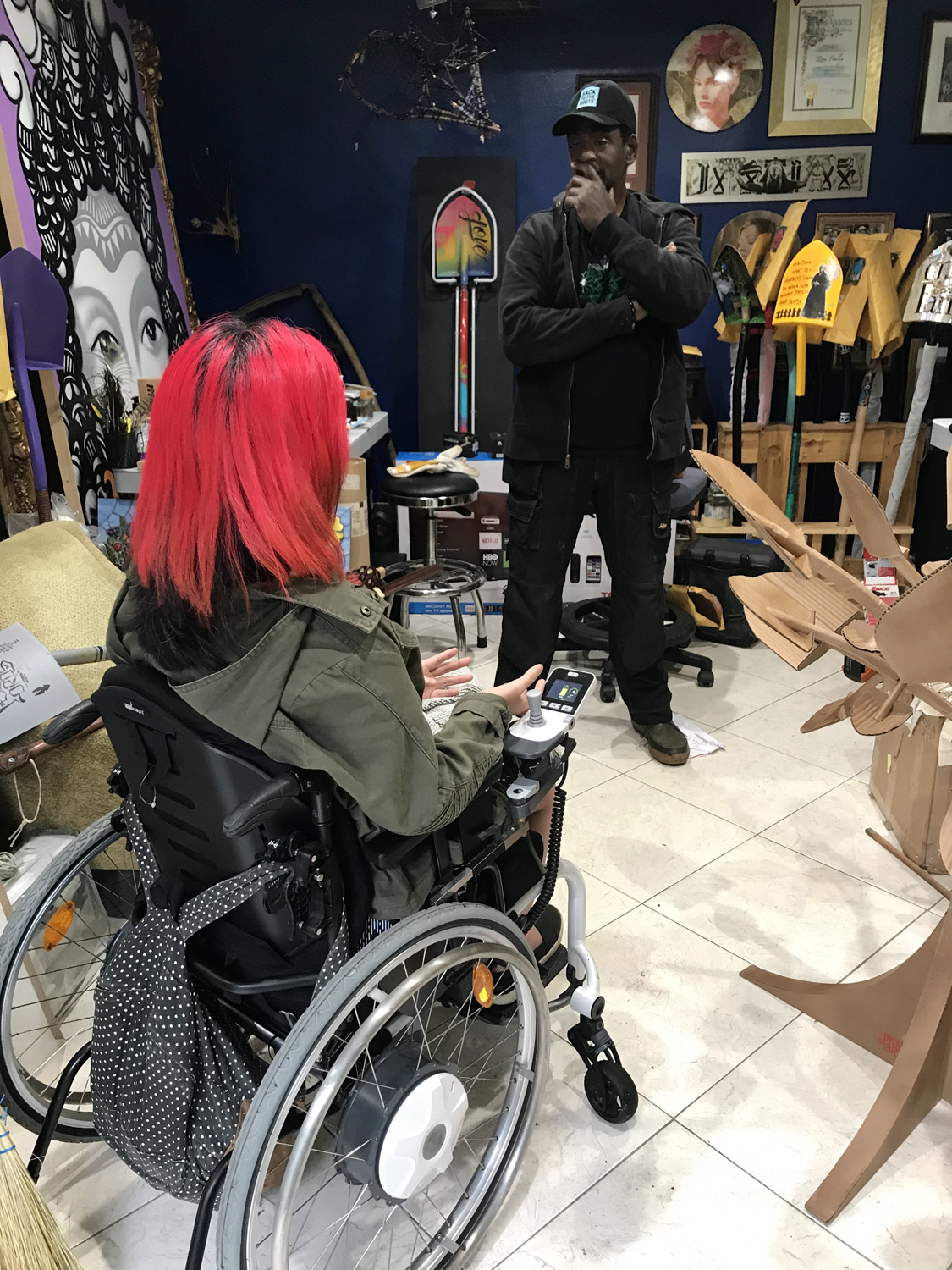It was another rainy SoCal Sunday. Weird statement for California but rain seems to be an unusual regular for SoCal this winter. After Jason and I struggled to load my chair and myself underneath the pouring rain, we made our way from coastal Orange County to South Central Los Angeles to visit a man and his garden.
As we unloaded from the car and rolled up to the address we began entering a very different environment all together. We knocked on the gate and waited while marveling how the rain seemed to temporarily part just for us and this visit.
Ron came down and immediately got to work in cleaning an aisle wide enough for my wheelchair to roll through his grounds. As he worked lifting numerous pots of vegetation lining his entrance, I marveled at his sidewalk garden. I had never seen anything like it, but how brilliant. This median was filled with an oasis of vegetation like New Zealand spinach, eggplant, mint, figs, tangerines, apricots, lemongrass, towering banana trees, mushroom patch, every herb you can think of, carrots, broccoli, some of the most amazing looking chard I’ve seen. The list goes on and on.
Who knew you could fit so much food in a curb strip?
Jason and Ron lifted me over the step and I was inside the famous backyard urban garden. It instantly felt more like I was in some cornucopian jungle than an inner-city neighborhood. The inside was filled with even more varied vegetation than the curb strip, like lemon trees, Valencia oranges, blackberries, pomegranates, plums, avocados, sweet potatoes, dragonflies and monarch butterflies making a stop before they head to Mexico…all in Southeast Central.
Ron Finley is a designer, artist and a self-taught gardener. But he’s so much more than these boxes. Finley, lovingly known as the “Gangsta Gardener”, is a community leader who has traveled around the world giving speeches; with a greater message of thinking bigger and freer.
Native to Los Angeles, but Detroit born, Finley grew up in Watts, CA during one of the most “defining revolutions” in the history of Los Angeles. Today he lives in South Central LA where defying the norms catapulted him onto an international stage.
As a teenager Finley felt the calling of a master tailor. His passion for fashion design and tailoring eventually earned him his own business with collections in Nordstrom, Saks Fifth Avenue and Neiman Marcus.
But the 2007 financial crash hit hard. The stores stopped calling.
Finley soon realized what he always knew, his area and others like it are food deserts. More like food prisons. In his Ted Talks Finley shares that in his community you have to drive 45 minutes for a fresh, nontoxic tomato. He quips in his Ted Talks:
“ Just like 26.5 million other Americans, I live in a desert, South Central Los Angeles, home of the drive-thru and the drive-by. Funny thing is, the drive-thrus are killing more people than the drive-bys…People are dying from curable diseases in South Central Los Angeles. The obesity rate in my neighborhood is five times what it is in Beverly Hills, eight miles away.”
Finley got tired of driving 45 minutes just for a tomato or an apple not implanted or doused with toxic cancer and disease causing chemicals. Or genetically modified tomatoes all designed to be the same size and coated with shellac to maintain that supermarket shine. He got tired of the dialysis centers popping up like drug stores. He got tired of seeing his friends with cancer and chronic diseases.
Finley wanted change so he began right outside the steps of his home. He planted an edible garden on the median between the sidewalk and the street. You know, that useless strip of dirt holding up our street signs?
Apparently, planting a small garden on a neglected plot of land littered with trash and condoms is illegal which meant Finley had a warrant out for his arrest. So he gathered fellow green activists and petitioned the right to garden and grow your own food. The city backed off and legalized parkway gardening, and Ron planting a single carrot unintentionally began a food revolution.
“
ignite a horticultural revolution” in which “gardening is gangsta, where cool kids know their nutrition and where communities embrace the act of growing, knowing and sharing the best of the earth’s fresh-grown food.
”
Most people don’t realize low-income neighborhoods and ghettos don’t have supermarkets…by design. These underserved areas have instead been terrorized with convenience stores stocked with junk food, liquor stores, fast food chains, drug stores, dollar stores, dialysis centers and never-ending stream of abandoned concrete lots; parking lots that could be community gardens. In the ghetto fast food is cheaper than produce so if you’re poor, your choice is fast food which leads to chronic diseases, poor health, obesity thus higher medical expenses and expensive social crises.
You are what you eat. If a child eats crap from beginning of their life, then they can’t develop theirs mind and bodies. What’s alarming is very little nutrition study is required to become a doctor.
But not all neighborhoods are treated equally. Look at Flint, Michigan and ask yourselves if any middle income and up neighborhood would accept toxic disease borne water for nearly FIVE years, or rather if this would ever happen in more “desirable” communities. These Flint victims, who live in the poorest city in America and also pay the highest rate for their (toxic) water in the nation, are now filled with lead and left with untreatable diseases, cancers, generational diseases and outbreaks with likely no real health insurance. Many have even died with no whimper from our leaders. ey’re so far from the start line now, it hurts. This would never happen in any of the towns I grew up in throughout my life or at least not ignored for these many years.
No matter what anyone says, not everyone starts at the same line and communities vary depending on wealth and color. What people don’t realize is communities of color are designed much different than other neighborhoods…in so many ways. This is not an opinion; it’s an unequivocal fact since the beginning of suburbia. In the 30s white neighborhoods were designed to keep out blacks and blacks were pushed to desolate neighborhoods and refused property ownership from the 30s to the 60s (FHA 1934 policy).
A lot of people out there make money exploiting the most vulnerable people on their knees and so many policies were and are designed to further decimate these communities. No access to real nutritional food but plenty of access to corners filled with fatty foods, alcohol and prescription drugs. This is called a food prison. When you’re too sick and education isn’t a priority to your leaders, you create a public that is unhealthy and unable to fight back…by design.
* * *
We have messed up all the basic things we need to stay alive like air, water and food.
I’m not here to debate on climate change, but even if you don’t believe in climate change, we can all agree on cleaner air and our right to be free from toxic cancer and disease causing chemicals in and on our food and water. That’s something we can all get behind.
If we think cancer and chronic diseases came out of nowhere, think again. According to NCBI/NIH only 5–10% of all cancer cases can be attributed to genetic defects which means the rise of cancer, and the other 90-95% of cases, is mostly due to our lifestyle and environment. If we think autoimmune and chronic diseases came out of nowhere, think again. Around about 30% of autoimmune disease risk is genetic so the rest is due to our lifestyle and the chemicals and pollution in our food, air, ground, water…everywhere. Yet I don’t hear a national message of preventive wellness, nor the honesty of what the chemicals in our environment and diets filled with processed fatty foods does to us. I don’t hear a national campaign of wellness prevention to combat the cancer and chronic disease epidemic as loud as “Give us money for a cure”.
Ever wonder why?
Because preventing illness is easier and cheaper than dealing with a disease that comes to fruition.
According to EPA there are around 80,000 chemicals registered for use, and less than 3000 have been well studied for safety in humans. Same goes with prescription pills. Many prescriptions have uncontrollable and debilitating side effects, like what happened last year to me. Most don’t realize pills can create other diseases and long-term adverse effects or even trigger a genetic predisposal. And then you have to take more pills to cover those issues which can cause more problems. Most drugs are not tested over a generation to truly see the effects they can have and/or other illnesses or diseases that arise as a result (Additional article: Drugs can induce diseases)
I’m not saying stop your meds, I’m saying be aware. No one will care about your health more than you will. Take it from someone who has struggled and been thrown around the health system for 20 years. It’s difficult and it's grueling but only you can be your own advocate. It’s frustrating because if doctors don’t even know (or care) the ill potency of mixing drugs or an individual who may be more sensitive to a drug that ignites a locked genetic disorder or a peripheral illness, then how can we? But you have to be involved.
I share because I don’t want others to be alone when they’re locked in the turmoil and imprisonment of their illness, their body and a health system that treats the sick and dying like commoditie$. To get diagnosed for my genetic muscle wasting disorder between 2000-2005 was incredibly difficult. I did my diagnosis journey utterly alone. No one was there for me until Jason came ten years later, and now he’s been enduring the fight with me in search of a diagnosis for my long list of chronic symptoms (close to a diagnosis). Through my experience he now sees what a screwed up system we have and what it takes for someone like me to get through daily life.
I’ve shared about my symptoms but haven’t really shared in detail what a daily nightmare it has been living with these chronic symptoms. So I personally know what Finley is talking about. To be a hostage of your body and ill health is immensely time-consuming and it’s time better spent on being involved with the causes and projects I care most about. My physical weakness is genetic born but you can never do enough to help your health along. So I’ve been doing everything in my control to improve my health naturally. While dealing with the medical world and searching for answers I completely changed my diet and eliminated processed foods and sugar because I’ve got shit to do and want nothing more than to exit this chronic prison. Living with a physical disability is hard enough so I want to do everything I can to help myself. On a daily basis I have debilitating fatigue and many days it takes all the energy I can muster just to get out of bed or even hold my neck up.
* * *
The rainy Sunday seemed to pause for our visit. Ron, Jason and I sat there for a while talking about art, food, gardening, politics, systemic structures, healthcare, culture, Detroit (I lived there for 5 years) and his artist sons.
Finley is clearly a people person. He cares about individual and communal growth. He travels the world and communities to empower others to grow gardens and be informed. One of his nonprofits put in gardens around South Central free-of-charge, and Finley urges locals to visit his curbside food forest so he can share what he has grown. But his efforts aren’t just about charity and gardening.
It’s not really about the food. It’s about potential and freedom. It’s about thinking beyond the systemic confines set up for us and that we don’t have to be subjugated to systems of control. He’s not saying to grow all your food or any food at all. But what if your community did? Gardens create community and real nutritious food void of toxic chemicals.
Finley’s mission is to promote community power and ideas and one of the ways to promote this sentiment is through art.
Last Autumn Ron got in contact with me via instagram and asked if I would contribute to his group art installation project called “Urban Weaponry” using weapons (shovels) of mass creation. Each artist paints a shovel that will be part of a larger traveling art installation.
Feeling insecure about not painting in awhile and the unknown difficulty of my languid arms and hands, I almost said “no”
At the time I actually knew very little about him. I only knew of his name because over the summer I visited “Beyond Street Art” exhibit downtown and one of his pieces, a pop-up garden, was front and center.
So, I went and researched what Ron Finley was about.
I’ve shared I primarily do digital art because it’s easier on my ever-weakening arms, hands and fingers. I haven’t painted in probably 10 years but I liked Finley’s message so much that, with Jason’s encouragement, I accepted the challenge.
Painting the shovel was very difficult, tiring and laborious...and even painful but I did it. It’s not something I can do all the time but I will try and continue doing smaller traditional pieces here and there. Everything an “abled” body does can take “disabled” ten times longer. It really does require fierce exertion to keep up. This painting process required a lot of organization, planning and many tiring weeks. I even consciously made my design more graphic so it would be easier to paint.
Overall, I’m so glad I said “yes”. It was a great experience and I couldn’t have done it without Jason’s undying physical support. We should’ve set up a camera to record us. He was the one doing all the heavy lifting, opening up paint tubes, moving the shovel at angles to match my limited paint strokes and more. I really couldn’t do most of the things I’ve done without him ❤️.
* * *
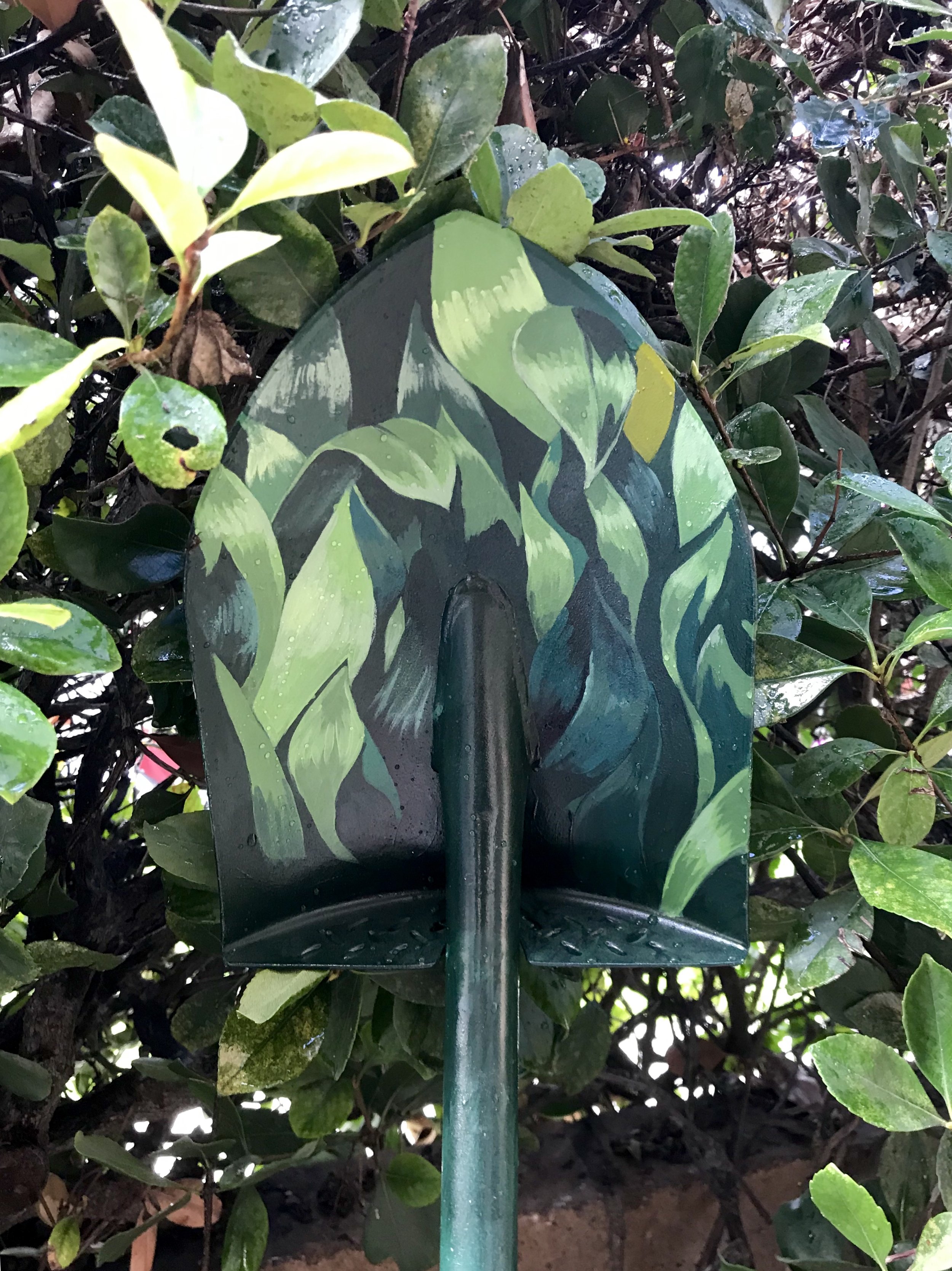
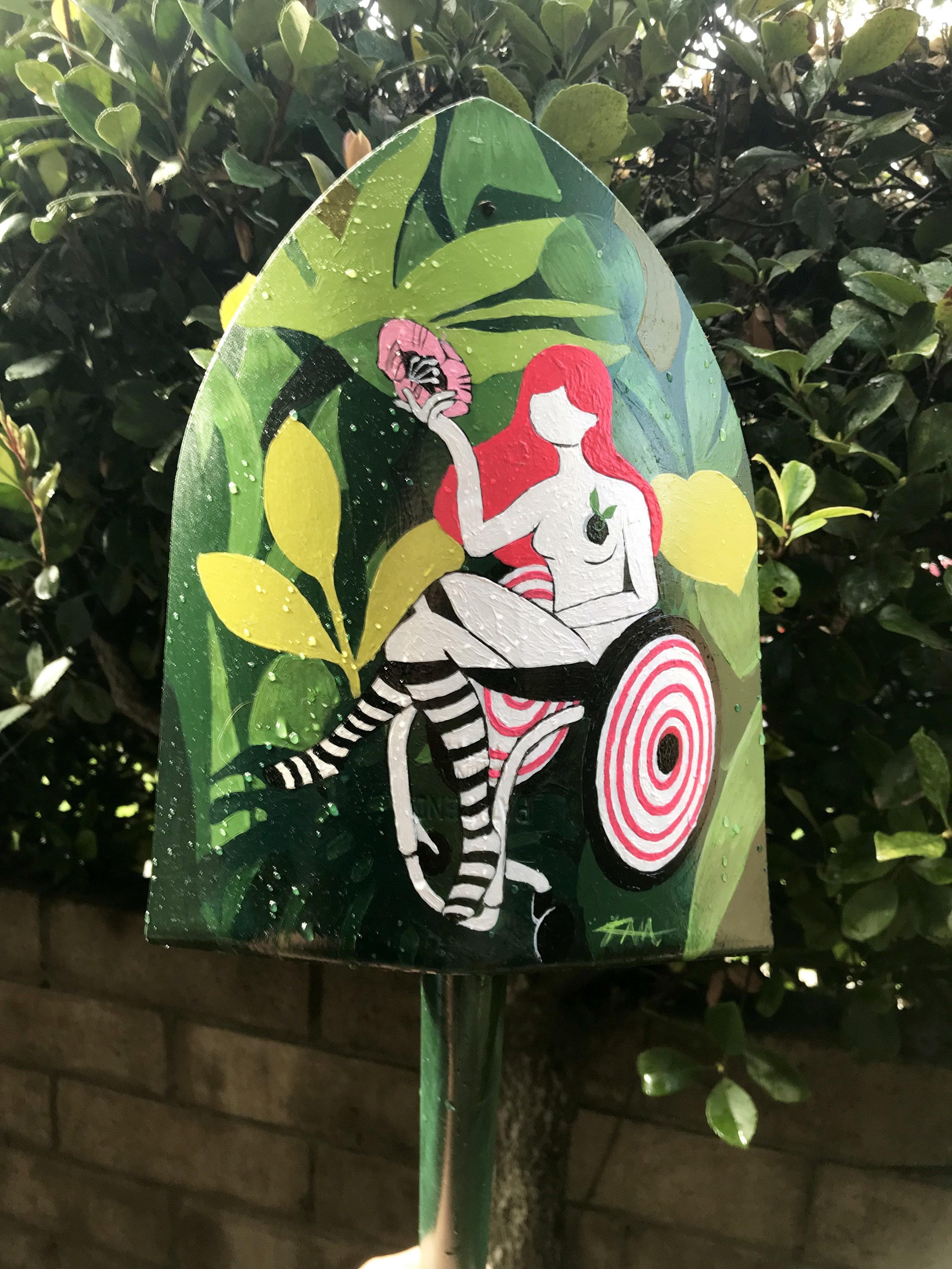
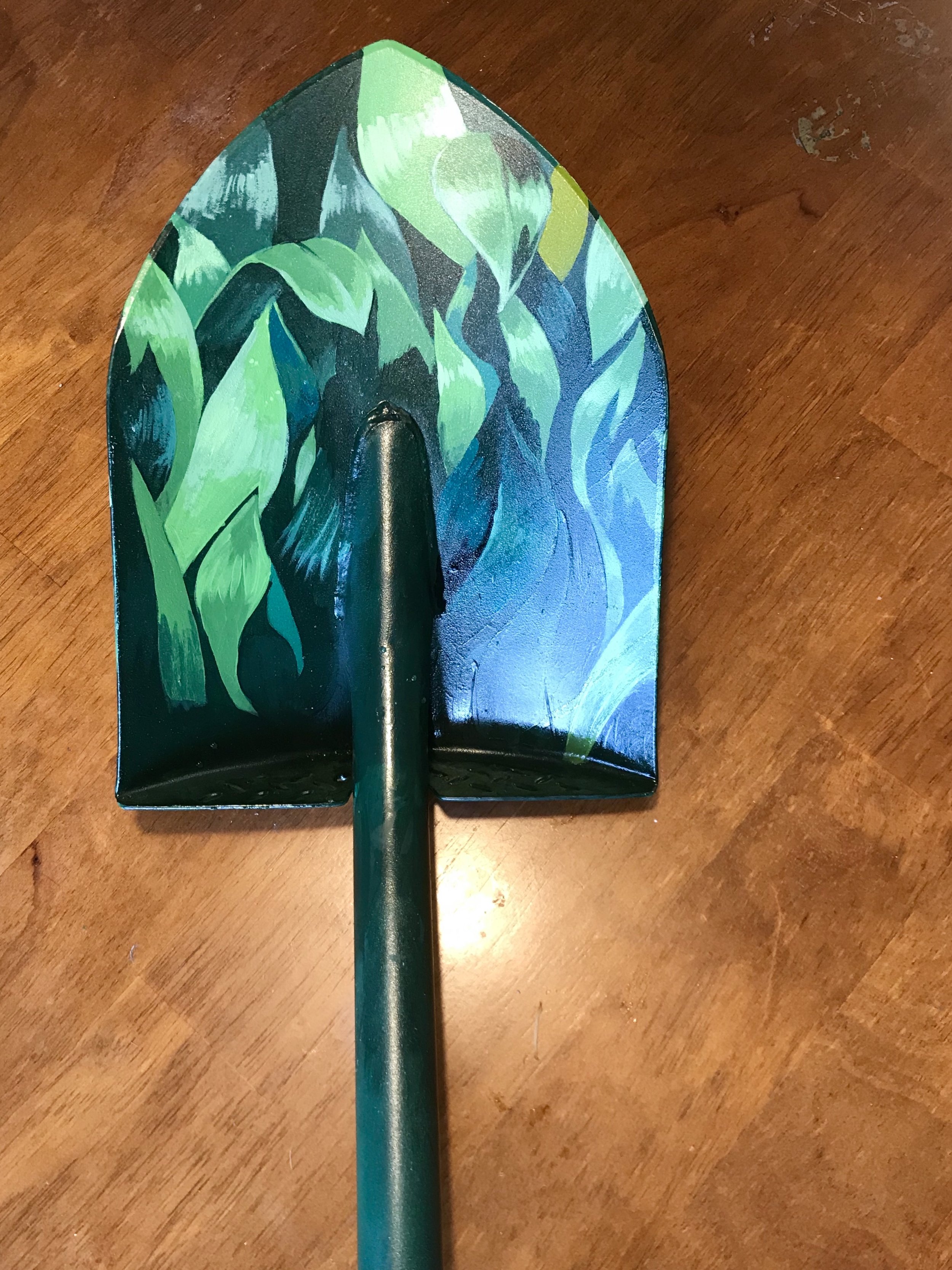
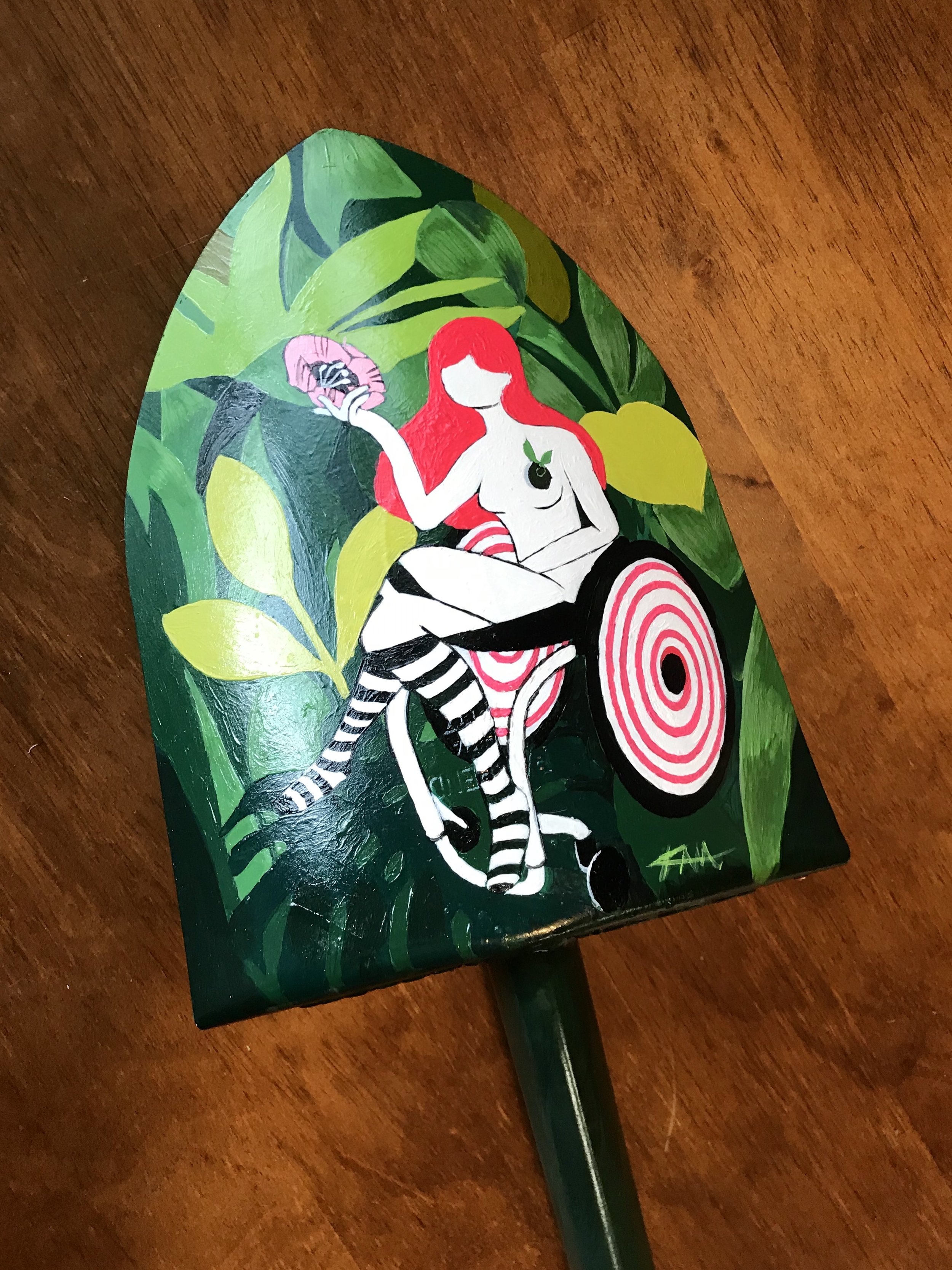
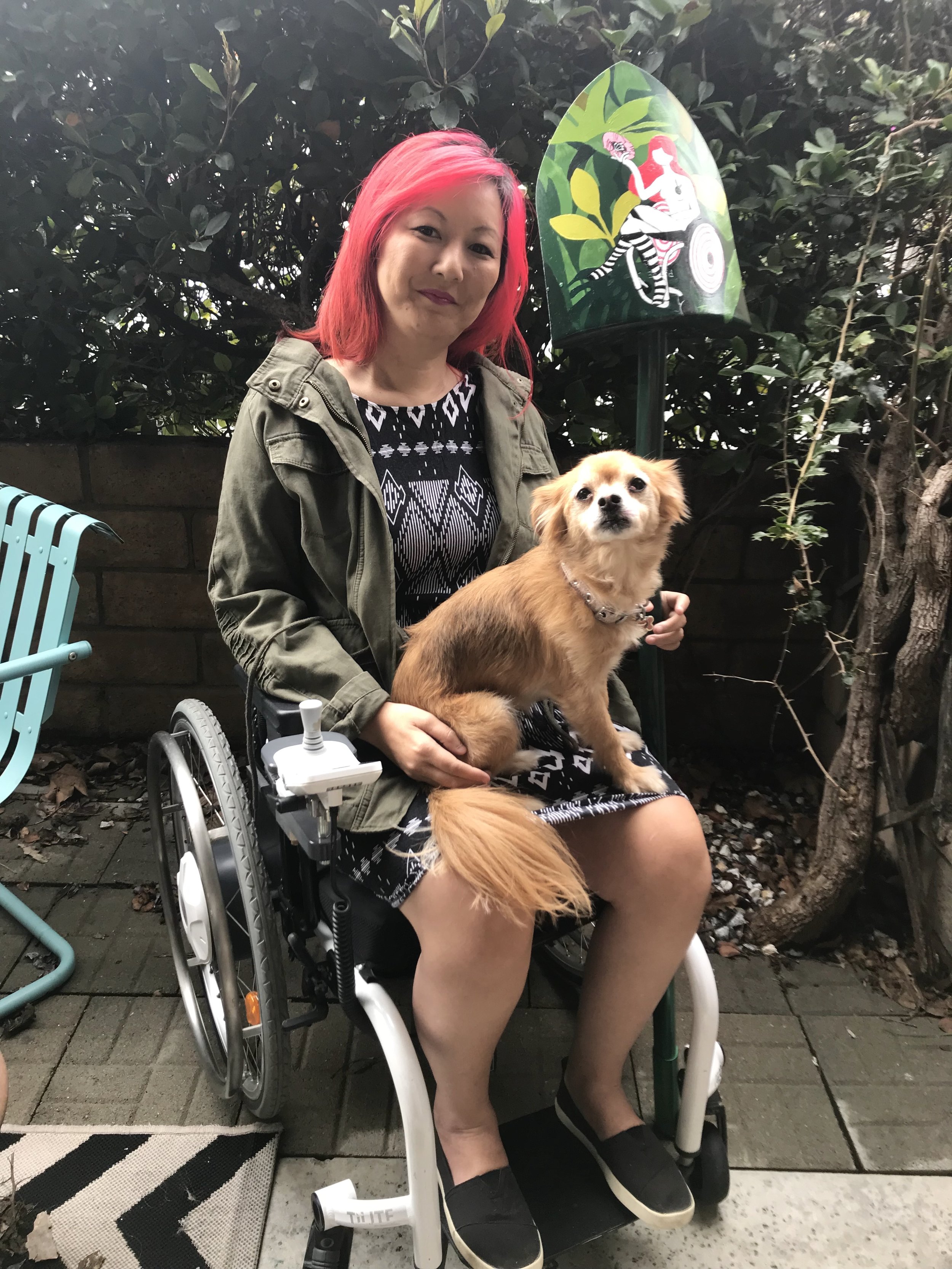
There’s nothing I love more than meeting varied and interesting people with interesting stories to tell. Stories expand us. They allow us — in whatever capacity — to experience a perspective that is different than our own. It’s an important wealth to aspire to, the wealth of experiences and knowledge to draw upon as you continue along on this earth.
I like people who think off the beaten path because the truth is you don’t have to accept every marketed social norm. You can think outside of mainstream, outside of what you’ve been told your whole life, outside “truths” designed to oppress and/or control you.
We all can make a difference for life isnt just about worrying about our own lives. If you see something wrong, get involved. Don’t just air your grievances about the system online; embark on change. It’s doesn’t have to be on a national level, it can be right outside your doorstep because communities can affect policy.
History tells us change NEVER happens within the system, it has to happen outside of it. If you do not raise your voice I assure the powers that be will not ask you for it. Finley raised his voice not in rage but in action.
* * *
Even though I’m an advocate for disability it should be apparent by now that I don’t just share about my wallows and struggles. I share what I’m passionate and inspired by because inspiration and passion is what carries me through the dark times. These are my weapons of choice.
Don’t let your problems take roots. Choose your weapon wisely and grow. Transform.
I’m fortunate to have met countless people holding a different perspective than mine. When I first decided to move to Los Angeles I was told it was all plastic fruit and nuts. I was genuinely terrified of such a spontaneous whim I was taking on. With my progressive disability, how was I going to get around a city not designed for me? How was a city based on pretty Hollywood going to accept someone different like me? But Los Angeles has been amazingly accepting of me, from Biking down the coast of San Francisco to LA through my grassroots project Bike for Kam, to advocacy, to LA Times and the art scene.
It’s easy to listen to surface interpretation of a place or person but really wherever you go you will attract like people, and LA is so much more than Hollywood. Any city, state or country is a complex diversity of stories that live beyond its reputation and genuine people? It’s up to you to find them.
As a self-taught illustrator I’ve managed to penetrate it, just a little, and I’m not going to let my health and disability stop me.
I’ve done things and met people I never thought I would and these types of adventures have allowed me to push the arduous milestones of this disorder.
Without it.
Who knows where I would be.
Thank you to Ron Finley for sharing himself, planting seeds for change and inviting me to contribute. And, as always thanks to my Jason who is always there supporting my dreams ❤️🌱.
Ron Finley’s story is also featured on documentary “Can You Dig This”. I haven’t checked it out yet but will 😉. Feel free to share this post :)
My art gallery
Follow my wheelchair travels, art and mini-memoirs at Instagram.com/kamredlawsk and Facebook.


